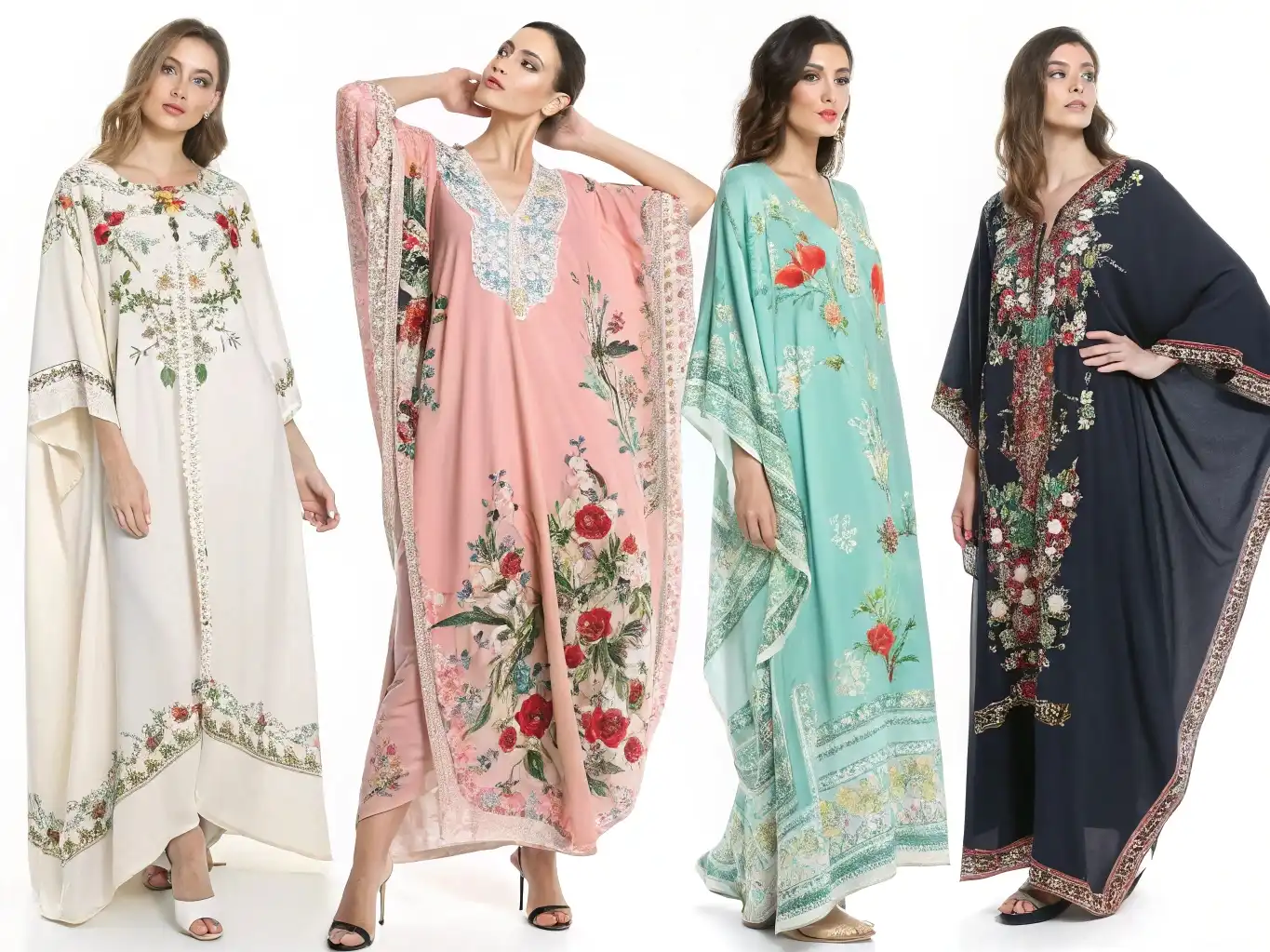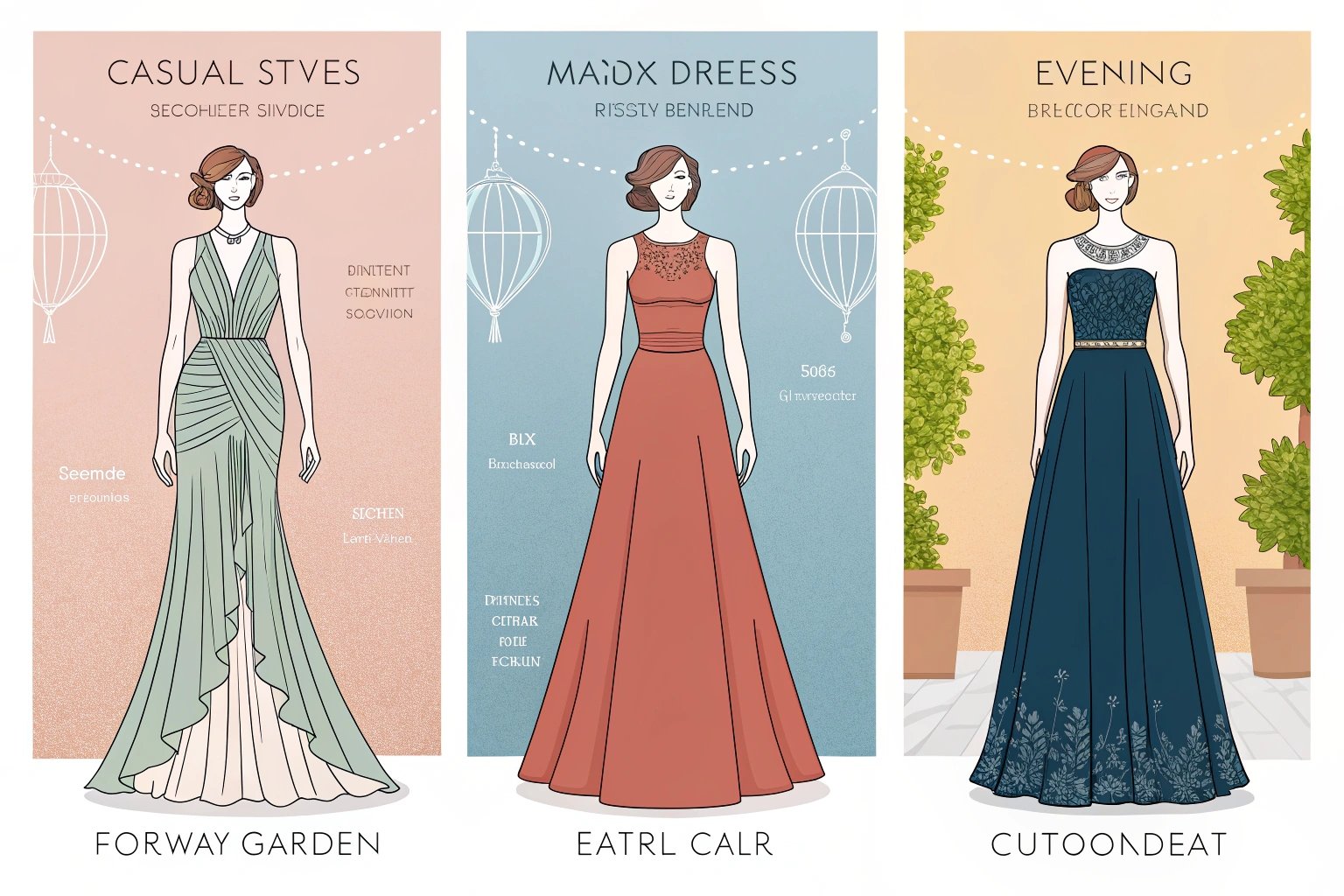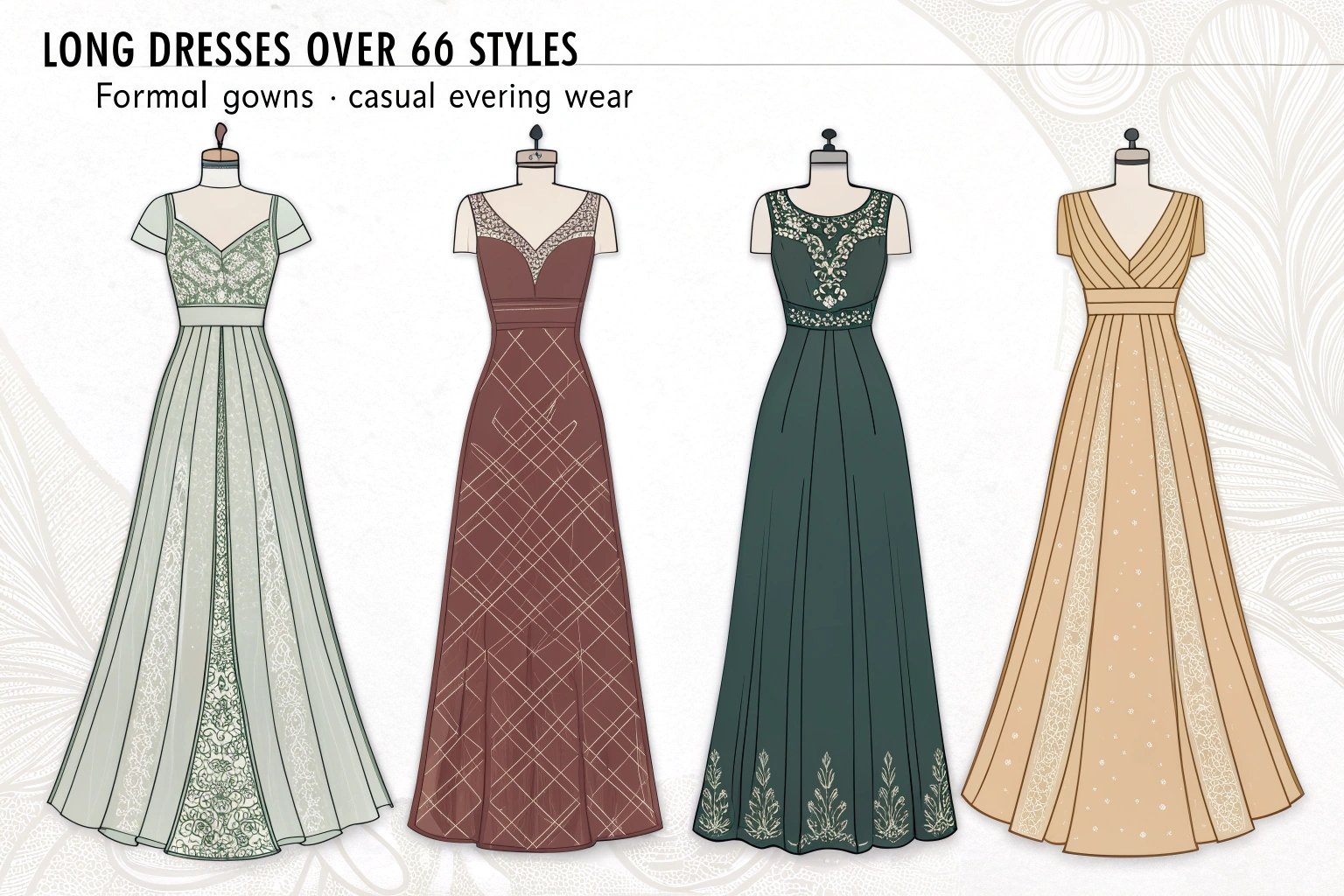Do you get overwhelmed by endless dress choices? Many women struggle to pick the right style for different occasions. I know this feeling too well—standing in front of my closet, second-guessing every option. But what if you could master dress types once and for all?
There are many types of dresses, each with unique shapes and features. When you understand the key styles, you can match your dress to your body type, the event, and your personal taste. This guide will help you make smart choices every time.
Once I learned how to identify the best dress styles, shopping became simple. I stopped wasting money on pieces I never wore. Keep reading, and you’ll soon recognize which styles highlight your best features—no more guessing or frustration.
A-line Dress
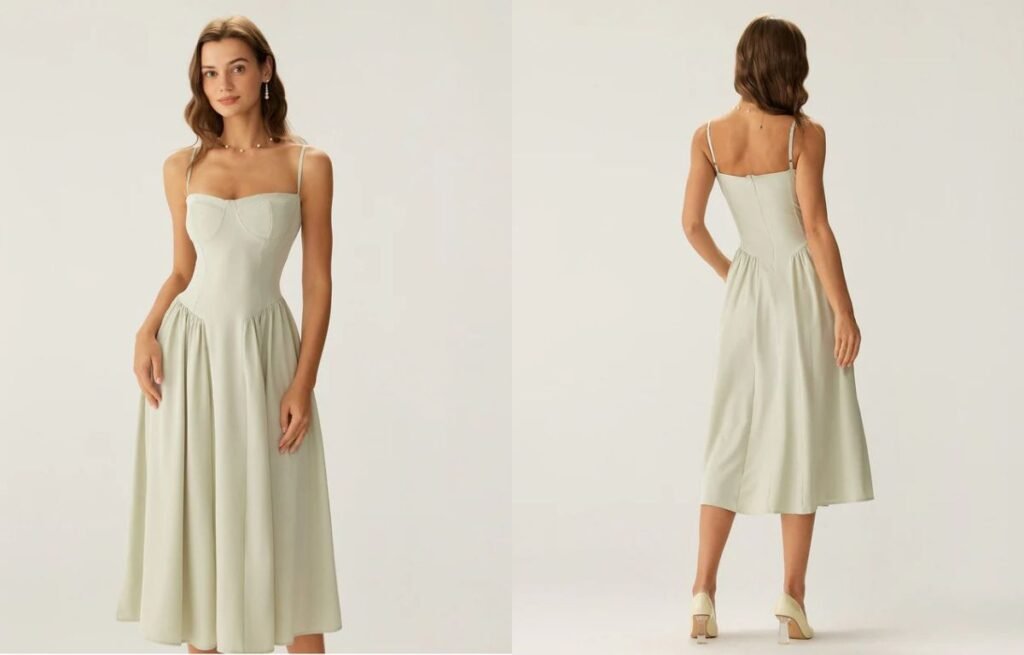
What Is an A-line Dress and Why Is It So Popular?
You see A-line dresses in every store, but what sets them apart? The secret is in their cut and fit.
An A-line dress is fitted at the top and gently flares out from the waist, creating a flattering and comfortable shape. This classic design works for most body types, making it popular for both formal and casual occasions.
The Design, History, and Universal Appeal of A-line Dresses
What Defines the A-line Shape?
The A-line is named after its resemblance to the capital letter “A.” The dress fits closely at the bust and waist, then widens smoothly toward the hem. This creates a balanced look that highlights the waist without hugging the hips or thighs.
A Brief History of the A-line
Christian Dior first popularized the A-line silhouette in the 1950s. Since then, designers have adapted it for everything from wedding gowns to office wear. Its enduring appeal is proof that classic design never goes out of style.
Why Do A-line Dresses Work for Most Body Types?
The A-line is a wardrobe hero for many reasons:
- Hourglass Figures: Accentuates a narrow waist.
- Pear Shapes: Skims over hips and thighs, offering balance.
- Apple Shapes: Draws attention to the waist, not the midsection.
- Rectangle Shapes: Adds the illusion of curves.
- Petite Frames: Creates length and elongation.
Fabric Choices and Construction
A-line dresses come in many fabrics. Cotton and linen are great for summer; wool and blends work for colder months. Heavier fabrics give more structure, while lighter fabrics create movement. Seam placement and skirt fullness can change the overall effect—some A-lines are subtle, others dramatic.
| Fabric Type | Effect on Silhouette | Season |
|---|---|---|
| Cotton | Soft, casual | Spring/Summer |
| Wool Blend | Structured, warm | Fall/Winter |
| Satin | Smooth, elegant | Events |
| Linen | Breathable, relaxed | Summer |
My Perspective
When I design for my clients, I always suggest at least one well-made A-line. Its adaptability lets you dress it up or down. For businesswomen, a tailored A-line brings authority. For bridesmaids or party guests, softer fabrics add romance. This shape is also forgiving after big meals—trust me, I’ve been grateful for that many times!
Bodycon Dress
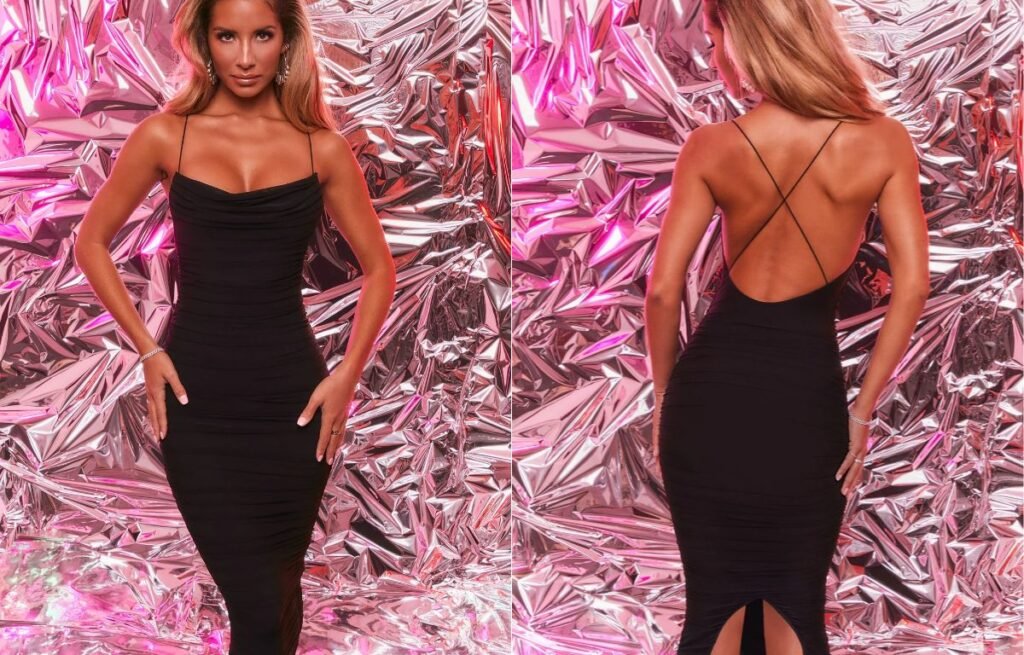
What Is a Bodycon Dress and Why Is It So Popular?
If you want a dress that puts your figure in the spotlight, bodycon is your answer. But what exactly makes it special?
A bodycon dress is tight-fitting and made from stretchy material, designed to mold to your body’s natural curves. Its popularity comes from its ability to create a bold, confident look for parties, clubbing, or evening events.
The Evolution and Design of Bodycon Dresses
How Bodycon Dresses Are Constructed
Bodycon is short for “body-conscious.” The fabric is usually a blend of spandex, polyester, or rayon. This elasticity creates a second-skin effect, showing off every contour.
History and Trend Influence
The bodycon dress surged to fame in the late 1980s and early ’90s. Hervé Léger’s bandage dress became an icon. Since then, bodycon styles appear on runways and red carpets, symbolizing confidence and sensuality.
Body Types and Perception
Bodycon dresses often spark debates about body positivity. While typically associated with hourglass figures, modern bodycon designs are more inclusive. With the right fit and styling, women of all shapes can rock this look.
Fabric and Structure
Quality matters. Thick, lined fabrics offer more support and smooth the silhouette. Cheaper, thin bodycon dresses can reveal too much, causing discomfort. I always check fabric thickness and stretch before buying or recommending to clients.
| Key Feature | Details |
|---|---|
| Fit | Extremely form-fitting |
| Material | Stretch blends (spandex) |
| Occasion | Night out, parties, events |
| Origin | 1980s-90s runway trend |
| Body Types | All (with right styling) |
My Perspective
The bodycon is not just for models. I have seen clients of every size embrace this style with confidence when they find the right length, neckline, and foundation garments. The key is owning the look, not hiding from it.
What Are the Pros and Cons of Wearing Bodycon Dresses?
The bodycon dress can transform how you feel, but it’s not for everyone—or every situation.
The main advantages of bodycon dresses are their confidence-boosting fit, strong visual impact, and modern vibe. Downsides include limited comfort, the need for careful undergarment choices, and less versatility compared to classic styles.
Should You Add Bodycon Dresses to Your Closet?
Pros
- Confidence Boost: Wearing bodycon signals boldness and self-acceptance.
- Evening Appeal: Perfect for parties, date nights, and high-energy events.
- On-Trend: Bodycon stays popular in pop culture and celebrity fashion.
Cons
- Comfort Issues: Tightness can be restrictive, especially for long periods.
- Every Detail Shows: Seams, underwear lines, or minor body insecurities can be more visible.
- Limited Occasion Range: Not ideal for professional or casual settings.
| Factor | Bodycon Dress | My Experience |
|---|---|---|
| Visual Impact | Very high | Always stands out in photos |
| Comfort | Medium to low | Fine for a few hours only |
| Versatility | Low | Not for daily wear |
| Figure Control | Needs shapewear/undergarment | Shapewear is essential |
My Advice
If you’re new to bodycon, start with midi lengths or dresses with built-in lining. Move, sit, and stand in front of a mirror before wearing it out. Never skip the right underwear—it makes or breaks the look.
Slip Dress
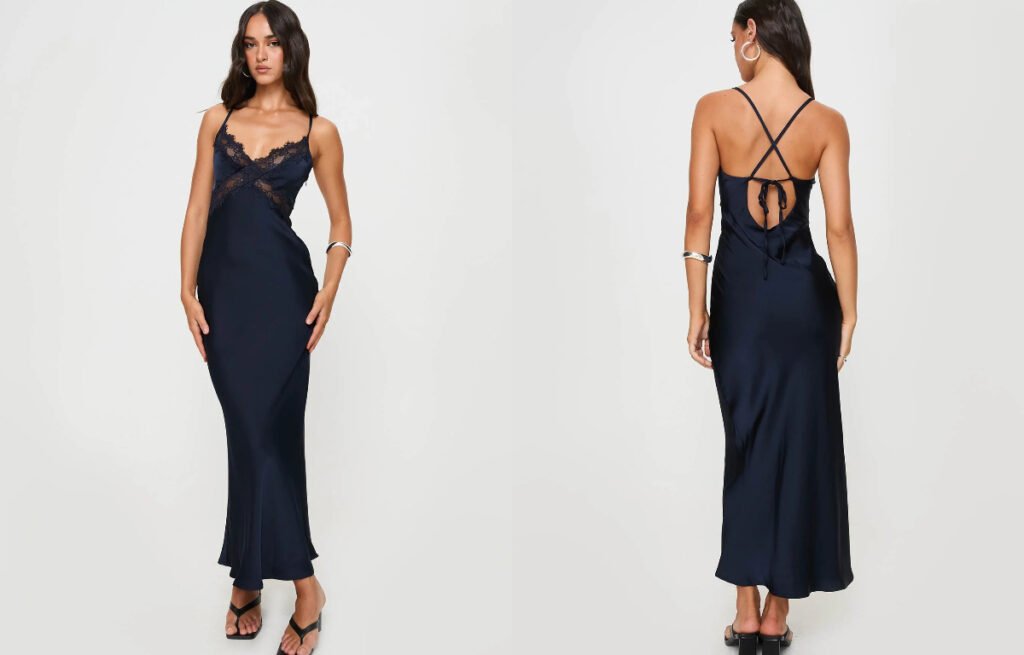
What Is a Slip Dress and Why Is It Trending Again?
You’ve seen it on runways and celebrities—but what exactly defines a slip dress, and why has it returned to the spotlight?
A slip dress features a straight, slightly loose cut with spaghetti straps and often a V or scoop neckline. Cut from silky or satin fabrics, its simple, minimal look can be dressed up or down. The slip dress has become a modern icon thanks to its versatility and effortless silhouette.
The History, Fabric, and Design of the Slip Dress
The Lingerie-to-Runway Evolution
Slip dresses began as undergarments, designed to sit smoothly under clothing. In the 1990s, designers like Calvin Klein and John Galliano brought the slip to the surface, transforming it into a statement piece for everyone from Kate Moss to today’s It-girls.
What Makes the Slip Dress Unique?
- Cut on the Bias: Most slip dresses are cut diagonally across the fabric. This allows the dress to skim the body without clinging, creating natural movement and a hint of drape.
- Fabrics: Common materials include silk, satin, viscose, and blends that mimic silk. These fabrics catch the light and elevate even the simplest design.
- Length and Detail: Slip dresses come in mini, midi, and maxi lengths. Some feature lace trim or subtle details, but most keep embellishment minimal.
| Feature | Details |
|---|---|
| Straps | Thin/spaghetti |
| Neckline | Usually V or scoop |
| Material | Silk, satin, viscose, polyester |
| Fit | Skims body, not too tight |
| Style Origin | Lingerie/undergarment |
| Key Appeal | Minimalist, versatile, timeless |
The New Slip Dress Trend
Recently, slip dresses have come back into style as people want effortless fashion that works for many settings. Celebrities and influencers wear them solo in summer or layer them for fall. This versatility is part of their growing popularity.
My Experience
I was hesitant at first, worrying it might look too revealing. But with the right fit and layering, my slip dress became one of my most worn—and most complimented—pieces.
What Are the Advantages and Disadvantages of Slip Dresses?
Not all dresses offer the same blend of comfort and sophistication. What sets the slip dress apart, and where does it fall short?
Slip dresses offer maximum comfort, a breezy fit, and can be styled for nearly any event. However, they can feel revealing, may require special undergarments, and sometimes cling in the wrong places if you don’t choose wisely.
The Practical Side of Slip Dresses
Advantages
- Comfort: Lightweight, non-restrictive, and perfect for hot weather.
- Versatility: Works for day or night, casual or formal with a change of shoes or layers.
- Minimal Effort, Maximum Impact: Instantly polished, even with minimal styling.
Disadvantages
- Can Be Revealing: Thin fabrics sometimes show lines or transparency.
- Undergarment Challenges: May need seamless or strapless solutions.
- Static & Cling: Some materials can stick to the body, especially in dry weather.
| Factor | Pro | Con |
|---|---|---|
| Comfort | Very high | N/A |
| Versatility | Can dress up or down | N/A |
| Ease of styling | Simple, minimal effort | N/A |
| Modesty | Shows more skin, can be sheer | Needs careful undergarment choice |
| Body confidence | Accentuates natural shape | Can highlight insecurities |
My Advice
Always try the slip dress in natural light and walk around to check how the fabric moves. Don’t be afraid to experiment with lengths—midi works on most people and feels less risky than mini or maxi.
Shirt Dress
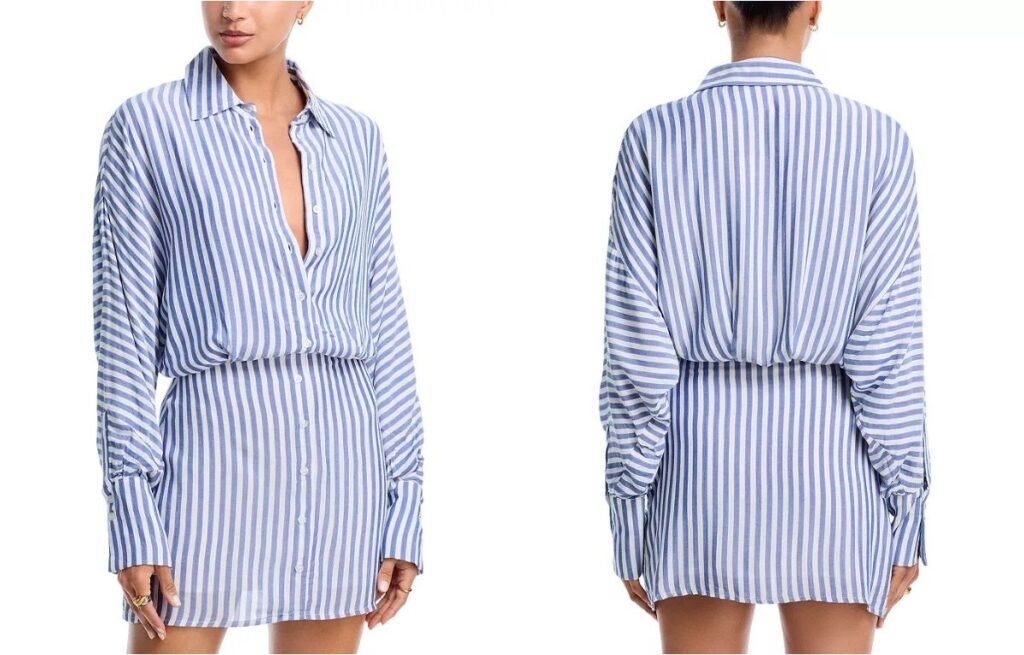
What Defines a Shirt Dress and Why Has It Remained Popular?
You’ll find a shirt dress in nearly every fashion collection, but what makes it unique and why do women keep coming back to it?
A shirt dress combines the tailored elements of a shirt—such as collars, cuffs, and buttons—with the length and comfort of a dress. Its appeal lies in its simplicity, versatility, and ability to flatter almost every body type.
The History, Structure, and Universal Appeal of the Shirt Dress
A Brief History
The shirt dress traces back to the 1950s when Christian Dior introduced full-skirted versions inspired by men’s shirts. Over decades, designers reimagined it, keeping its core features—buttoned front, collar, and adjustable waist—while playing with fabrics and silhouettes.
Structural Elements
- Collar: Adds polish and structure
- Button Front: Adjustable, allows for custom styling
- Sleeves: Can be short, long, or rolled
- Waist Tie/Belt: Defines the waist, creates shape
- Hemline: Ranges from mini to midi, sometimes even maxi
| Feature | Why It Matters |
|---|---|
| Collared neck | Professional or casual |
| Button placket | Adjustable coverage |
| Belt/tie waist | Custom fit, flatters shape |
| Versatile fit | Skims but doesn’t cling |
| Varied lengths | Suits many occasions |
Why It Works for Every Body
The shirt dress flatters all figures because it isn’t too fitted or too loose. You can adjust the belt for your waist, roll up sleeves, or layer for your ideal silhouette. Its structure means it works for curves, straighter frames, and petites alike.
My Experience
I rely on shirt dresses during busy weeks—they’re a safe, stylish option that always feels put-together. With fabric and styling changes, I can wear the same silhouette for business meetings, weekend errands, or a dinner date.
What Are the Advantages and Disadvantages of Shirt Dresses?
No dress is perfect for every situation. What do shirt dresses do best—and where do they sometimes fall short?
Shirt dresses offer exceptional comfort, adaptability, and a universally flattering fit. However, cheap fabrics or poor tailoring can make them look shapeless, and improper styling can give a boxy appearance.
Shirt Dress Pros, Cons, and Comparison
Advantages
- Versatility: Works for all seasons and settings.
- Adjustability: Waist tie allows you to control the fit.
- Effortless Polishing: Instantly elevates your look without much thought.
- Layering Potential: Can be worn open as a duster or closed as a dress.
Disadvantages
- Risk of Boxiness: Without a defined waist or good fit, it can look shapeless.
- Fabric Matters: Thin or stiff fabrics lose elegance quickly.
- Length Challenges: Too short can feel revealing, too long can overwhelm petites.
| Factor | Shirt Dress | My Take |
|---|---|---|
| Comfort | Very high | All-day wear |
| Adaptability | Excellent | From office to travel |
| Flattering | For most, if belted | Adds waist, skims hips |
| Formality | Wide range | Can be casual or dressed up |
| Fabric Issues | Watch for cheap blends | Invest in quality cotton |
My Advice
I always recommend trying on several versions. Look for a defined waist and a length that hits just above or below the knee for maximum wearability. Don’t be afraid to get it tailored.
Wrap Dress
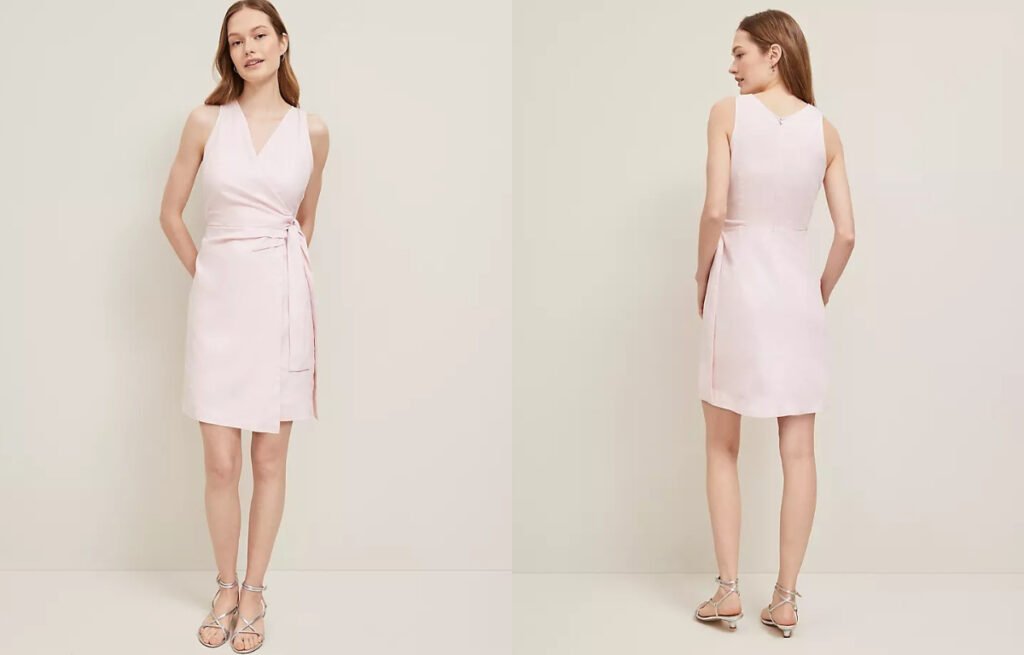
What Is a Wrap Dress and Why Does It Work for Everyone?
You’ve seen it in every decade, on every type of woman. What makes the wrap dress stand out?
A wrap dress crosses in the front and ties at the waist or side, creating a custom fit that flatters the bust and waist while skimming over hips. This simple yet powerful design is what gives it such universal appeal.
The History, Mechanics, and Magic of the Wrap Dress
A Fashion Revolution
Diane von Fürstenberg made the wrap dress famous in the 1970s, but the idea is much older. Its rise came from practicality—easy to put on, easy to adjust, and appropriate for almost any setting.
How Does It Flatter Every Body?
- Adjustable Fit: The self-tie design lets you tighten or loosen at the waist as needed.
- V-Neckline: Naturally elongates the neck and flatters the bust.
- Waist Emphasis: The tie accentuates the narrowest part of your torso.
- Skimming Skirt: Flows over hips and thighs, balancing proportions.
Versatility Across Ages and Stages
Wrap dresses work through body changes—weight fluctuations, pregnancy, or postpartum. I’ve recommended them to clients from college age to retirees, and they always deliver a confident fit.
| Feature | Why It Matters |
|---|---|
| Adjustable waist | Custom comfort and fit |
| V-neck | Slimming, frames the face |
| Flared skirt | Camouflages hips and thighs |
| All fabrics | Works in jersey, silk, cotton, linen |
My Perspective
When I’m styling someone unsure about their shape, the wrap dress is my go-to. It’s the most forgiving and body-positive silhouette I know.
What Are the Advantages and Disadvantages of Wrap Dresses?
The wrap dress is close to perfect, but no dress is flawless. What should you expect?
Wrap dresses offer adjustability, comfort, and a tailored look for every figure. Downsides include possible wardrobe malfunctions and the need for proper underlayers or pins to keep everything in place.
The Real-World Pros and Cons of Wrap Dresses
Advantages
- Customizable Fit: Ideal for weight changes or those between sizes.
- Universally Flattering: Accentuates curves or adds shape to straighter bodies.
- Comfortable Movement: Allows easy walking, sitting, and eating.
- Works Year-Round: Available in lightweight summer fabrics or cozy knits for winter.
Disadvantages
- Neckline Gaps: The V-neck may gape open when you move.
- Tie Slippage: If not tied securely, the dress can loosen through the day.
- Potential Exposure: On windy days, the skirt can fly open.
- Layering Needs: Sometimes requires a cami or safety pin for modesty.
| Factor | Wrap Dress | My Advice |
|---|---|---|
| Comfort | Very high | Go for jersey for max comfort |
| Flattering | All shapes | Adjust tie for best look |
| Versatility | High | Dress up or down |
| Modesty | Needs attention | Add a slip or pin if needed |
My Advice
I always check the neckline in a mirror and practice moving around before leaving the house in a wrap dress. For windy days, I add a half slip or biker shorts underneath.
Maxi Dress
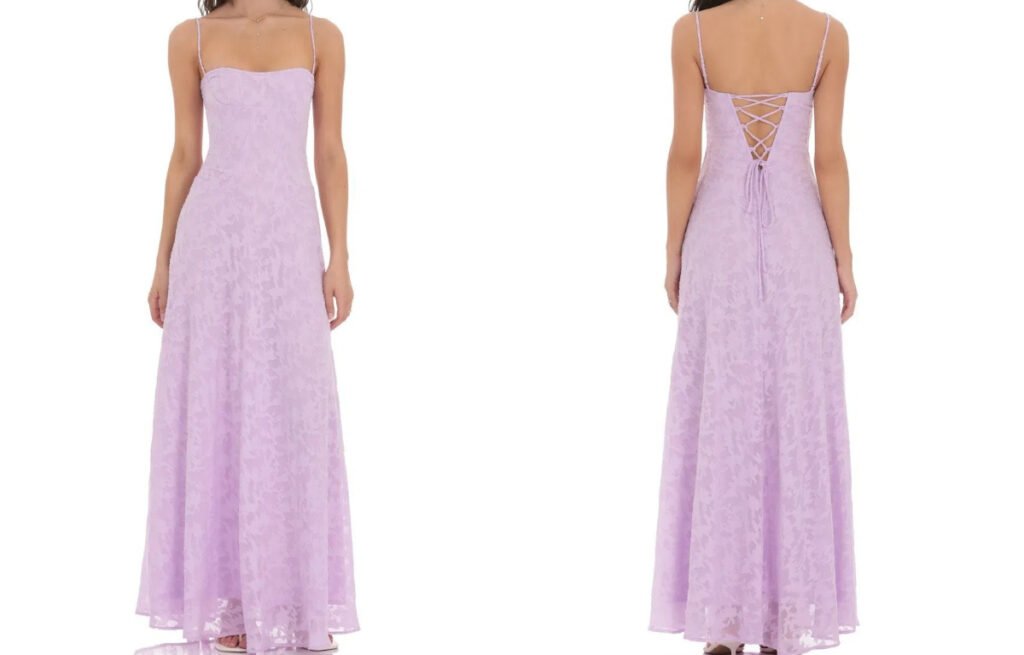
What Is a Maxi Dress and Why Is It So Popular?
Every summer, you’ll see maxi dresses everywhere. But what defines this style and why does it never go out of fashion?
A maxi dress is characterized by its full-length cut, often from lightweight fabrics, and a relaxed fit that flows over the body. Its main appeal lies in its comfort, modesty, and versatility for both casual and formal settings.
History, Key Features, and Universal Appeal of Maxi Dresses
Origins and Evolution
The maxi dress rose to popularity in the late 1960s, representing freedom and bohemian style. Over the years, designers have updated the silhouette with new fabrics, prints, and details—making it suitable for everything from festivals to weddings.
What Makes a Maxi Dress Unique?
- Length: Typically reaches the ankle or floor, sometimes with a slight train.
- Fit: Ranges from fitted bodices with flowing skirts to loose, oversized shapes.
- Fabrics: Cotton, viscose, chiffon, jersey, and even knits for winter versions.
- Details: Can feature slits, off-the-shoulder necklines, sleeves, or wrap designs.
Why It Works for Every Body
- Tall: Highlights height and movement.
- Petite: Choose higher waists and minimal prints for elongation.
- Curvy: Flattering drape without clinging; draws attention upward with V-necks or embellishments.
- Expecting Moms: Popular for maternity wear due to comfort and adjustability.
| Feature | Description | My Styling Tips |
|---|---|---|
| Length | Ankle/floor | Alter to just skim the shoes |
| Fabric | Light for summer, knit for fall | Match fabric to the season |
| Neckline | V, scoop, halter, off-shoulder | Choose to highlight your assets |
| Skirt style | Flared, A-line, tiered | More flare = more movement |
My Perspective
Maxi dresses have saved me on days when I want to look put-together but don’t want to overthink my outfit. They’re perfect for hot weather, but I also layer them for cooler months.
What Are the Pros and Cons of Maxi Dresses?
No dress is perfect for everyone or every event. The maxi dress is no exception.
Maxi dresses offer unbeatable comfort, easy elegance, and wide styling options. However, they can overwhelm petite frames, sometimes feel too casual, and require attention to fabric weight and length for best results.
When Does a Maxi Dress Work Best—and When Doesn’t It?
Pros
- Maximum Comfort: Loose fits make movement easy.
- Great for Coverage: Ideal if you want to protect your skin or prefer modesty.
- All-Season Potential: With the right layers, maxis work in any weather.
- Dress Up or Down: Change shoes and accessories to fit the occasion.
Cons
- Length Issues: Too long can cause tripping; too short loses the “maxi” effect.
- Overwhelming for Petites: Can swamp smaller frames if not styled well.
- Fabric Traps Heat: Some synthetic versions feel hot and sticky in summer.
- Too Casual for Formal Events: Needs luxe fabric and accessories to elevate.
| Factor | Maxi Dress Strength | Watch Outs |
|---|---|---|
| Comfort | Very high | None |
| Versatility | High | Not for formal black-tie |
| Suitability | Most body types | Petite: mind length/proportion |
| Seasonal Use | Year-round with layers | Fabric can be too hot or too thin |
My Advice
Try before you buy, especially if you’re under 160cm (about 5’3”). Don’t be afraid to hem or tailor for a custom fit.
Midi Dress
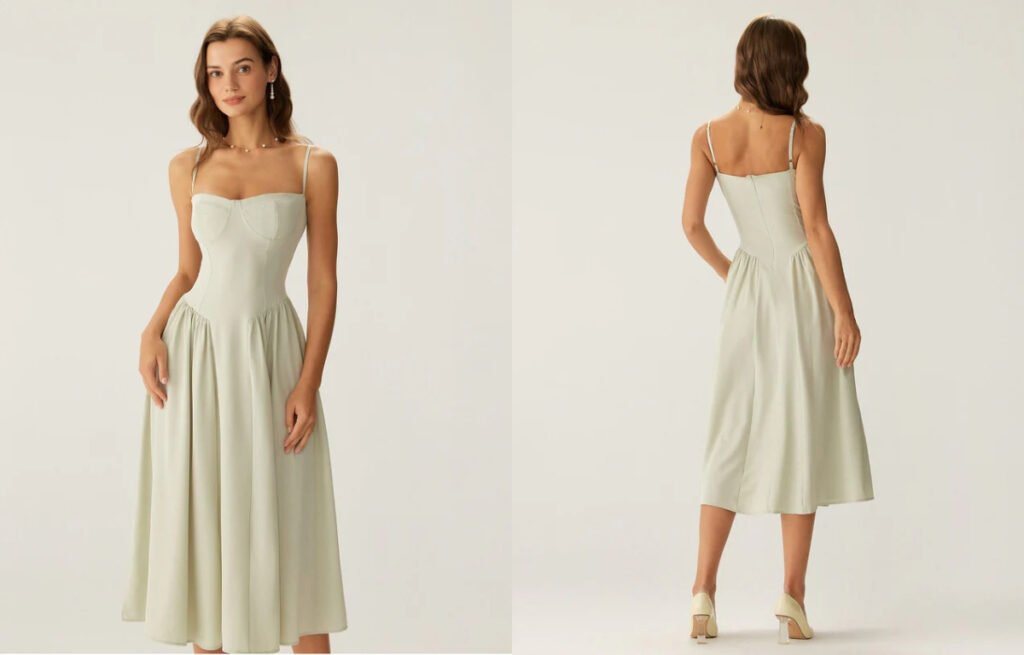
What Is a Midi Dress and Why Is It So Popular?
Why do fashion editors and designers keep coming back to the midi dress?
A midi dress features a hemline that falls between the knee and ankle, usually mid-calf. This length creates a polished look that feels modern, modest, and elegant, making it a favorite for women of all ages and body types.
History, Fit, and Fashion Impact of Midi Dresses
The Evolution of the Midi
Midi dresses first appeared in the 1940s and surged back into popularity in the 1970s. In recent years, midis have dominated runways and high street shops because they offer both comfort and style. Designers experiment with shapes, prints, and fabrics, proving that midi is more than a trend—it’s a staple.
Key Features and Variations
- Length: Anywhere from below the knee to mid-calf.
- Silhouette: Can be fitted, A-line, pleated, wrap, or body-skimming.
- Fabrics: Cotton for daytime, silk or satin for events, knits for cooler weather.
- Neckline & Sleeves: High, V-neck, halter, long or short sleeves—endless options.
| Feature | Description | My Styling Tips |
|---|---|---|
| Length | Below knee to mid-calf | Avoid awkward halfway points |
| Fit | Fitted or flowy | Define waist for best look |
| Fabric | Cotton, knit, silk, satin, crepe | Choose by occasion |
| Versatility | Day-to-night, work-to-weekend | Accessorize to set the mood |
Why Midi Works for Most Bodies
Midis are ideal for those who want coverage without looking frumpy. For petites, a midi with a defined waist and higher hem elongates the legs. Taller women can play with bold prints or fuller skirts.
My Perspective
When I help clients choose versatile pieces, I always include a midi dress. It’s the one length that adapts to most situations and makes you look put-together with almost no effort.
What Are the Strengths and Drawbacks of Midi Dresses?
The midi dress isn’t flawless, but its benefits usually outweigh its challenges.
Midi dresses offer sophistication, ease, and seasonless style. Their only real challenges are proportion (especially for petites) and finding the exact right hem length for your height and shoes.
A Closer Look at the Pros and Cons
Strengths
- Polished Look: The mid-calf hemline is instantly elegant.
- Comfort: Movement-friendly, especially with flared or pleated skirts.
- Adaptability: Perfect for work, brunch, travel, or weddings.
- Seasonless: Works with sandals in summer, boots and layers in winter.
Drawbacks
- Awkward Proportion Risk: Hitting at the widest part of the calf can look unflattering if not carefully chosen.
- Can Shorten Legs: Especially if worn with flats or bulky shoes.
- Fabric Matters: Thin, clingy fabrics can look cheap at midi length.
| Factor | Midi Dress Advantage | Challenge |
|---|---|---|
| Sophistication | High | Needs careful accessorizing |
| Movement | Easy to walk/sit | Wide skirts need hemming |
| Suitability | Most ages/shapes | Petite: try above mid-calf |
| Layering | Layers well for all seasons | Avoid bulk with outerwear |
My Advice
If you’re under 165cm (about 5’5”), go for midi dresses that hit just below the knee and always try them with the shoes you’ll wear most. I often have midis hemmed for the perfect length.
How Can You Style a Midi Dress for Every Occasion?
The midi dress is a true blank canvas—here’s how to make it fit your style and schedule.
Midi dresses transition from office to evening with simple swaps: add a blazer and pumps for work, switch to sandals and a denim jacket for weekends, or heels and statement earrings for a wedding or date.
Styling Midi Dresses Like a Pro
For Work
- Pair a tailored midi with a blazer and classic pumps.
- Belt the waist to add shape.
- Stick to solid colors or subtle prints.
For Casual Days
- Layer a cardigan or cropped jacket over a flowy midi.
- Choose sneakers or ankle boots.
- Add a crossbody bag for a laid-back vibe.
For Events or Night Out
- Opt for silk, satin, or wrap midis.
- Style with strappy heels or wedges.
- Elevate with bold earrings or a statement clutch.
For Cold Weather
- Layer a fitted turtleneck underneath or a chunky knit over.
- Wear with tall boots and a long coat.
- Add a scarf and textured tights for warmth.
| Occasion | Outerwear | Shoes | Accessories |
|---|---|---|---|
| Work | Blazer, trench | Pumps, loafers | Belt, tote, watch |
| Weekend | Denim jacket | Sneakers, flats | Crossbody bag, hat |
| Night Out | Shawl, cropped jacket | Heels, wedges | Statement jewelry |
| Winter | Coat, cardigan | Boots | Scarf, tights |
Personal Story
One of my best work outfits last fall was a knit midi with ankle boots and a fitted blazer. I felt professional, comfortable, and stylish all day, with no need to change for dinner afterward.
Mini Dress
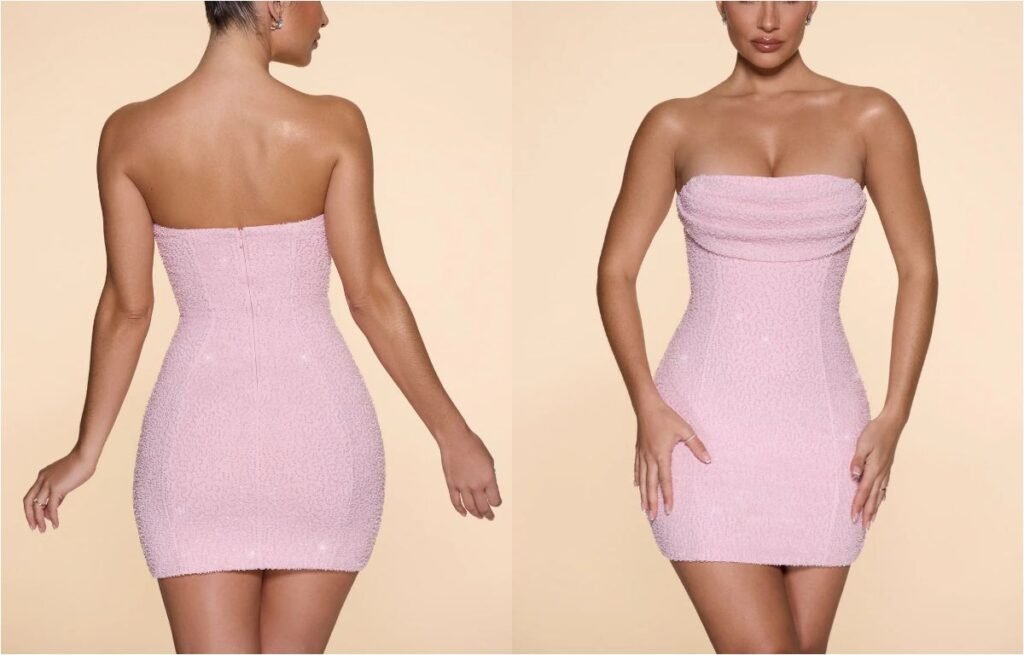
What Is a Mini Dress and Why Does It Stay in Style?
The mini dress has been a fashion revolution since the 1960s. But what really sets it apart, and why is it still so popular?
A mini dress is any dress with a hemline that ends well above the knees, often mid-thigh. Its bold, leg-baring cut has made it a favorite for decades, symbolizing freedom, confidence, and a playful attitude.
The History, Key Features, and Universal Appeal of the Mini Dress
The Birth of the Mini Dress
Mary Quant popularized the mini dress in London during the swinging ’60s, turning it into a symbol of youth and cultural change. Since then, every era has reimagined the mini—from mod and punk to today’s runways.
What Makes a Mini Dress Unique?
- Hemline: Always above the knee, often much shorter.
- Silhouettes: Can be bodycon, A-line, shift, wrap, or even shirt-dress style.
- Fabric Choices: Everything from cotton and denim to sequins, lace, and leather.
- Occasions: Parties, clubbing, beach days, summer strolls, concerts.
Who Looks Good in a Mini Dress?
- Long Legs: Show them off!
- Petite Frames: Mini dresses add the illusion of height.
- Hourglass or Athletic: Both fitted and loose minis can work with the right styling.
| Feature | Description | Styling Tip |
|---|---|---|
| Hemline | Above knee, usually mid-thigh | Always sit and move-test fit |
| Fit | Fitted, A-line, shift, wrap, shirt | Choose what flatters your shape |
| Fabrics | All: cotton, denim, sequins, knits | Consider occasion and season |
| Best for | Legs, petites, parties, hot weather | Add layers for more coverage |
My Perspective
Mini dresses have helped me step out of my comfort zone. Even if you’re not “leggy,” the right mini, paired with smart layers and shoes, can work wonders for confidence.
What Are the Advantages and Drawbacks of Mini Dresses?
Minis look fun and easy, but there are real pros and cons to wearing them.
Mini dresses create a youthful, energetic look and are perfect for hot weather and party settings. However, they can feel too revealing, may limit your movement, and are not always appropriate for formal or conservative environments.
The Reality of Wearing a Mini Dress
Advantages
- Highlight the Legs: The main focus, ideal if you love this feature.
- Feel Young and Playful: Wearing a mini always lifts my mood.
- Stay Cool: Perfect for summer and travel.
- Styling Freedom: Works with flats, heels, boots, or even sneakers.
Drawbacks
- Coverage Issues: Sitting, bending, or windy days can be tricky.
- Not Always Appropriate: Work, formal, or traditional settings may call for more length.
- Comfort Limits: Need confidence and the right undergarments.
| Factor | Mini Dress Strength | Challenge |
|---|---|---|
| Style Impact | Very high, bold | Needs right setting |
| Comfort | High (if fitted well) | Risk of wardrobe malfunction |
| Versatility | Great for parties, less for work | Layering required |
| Body Type | Flatters legs, petites | Not for everyone |
My Advice
When in doubt, try a slightly longer mini, or style with opaque tights for confidence and ease. I always check how I look and feel when moving, not just standing still.
Empire Waist Dress

What Is an Empire Waist Dress and Why Is It Timeless?
This design has survived centuries of changing tastes. But what exactly defines the empire waist, and why does it keep coming back?
An empire waist dress places the waistline just under the bust, letting the fabric flow down over the stomach and hips. This design gives the illusion of longer legs, creates gentle curves, and works well for many body types—from petite to plus, and even maternity.
The History, Fit, and Unique Power of the Empire Waist
A Brief Fashion History
The empire silhouette dates back to the late 18th and early 19th centuries—think Jane Austen and classic Regency style. It’s been reinvented many times, from Grecian gowns to boho festival looks and modern evening wear.
Why It Flatters
- Lengthens the Body: High waist draws eyes upward, making legs appear longer.
- Comfort for All: The loose skirt is comfortable for different body shapes, including pregnant women.
- Softly Romantic: Creates a feminine, graceful outline without tightness.
Design Elements
- Bodice: Usually fitted, often with a V-neck or square neckline.
- Waist: Seam sits just below the bust, not at the natural waist.
- Skirt: Flows out—can be straight, A-line, or gathered for fullness.
- Fabrics: Everything from flowing chiffon to structured cotton or velvet.
| Feature | Why It Matters | Styling Tip |
|---|---|---|
| High waistline | Elongates and slims the frame | Pair with heels for effect |
| Flowing skirt | Skims over hips/stomach | Choose lighter fabrics for grace |
| Neckline | Frames bust/shoulders | V-necks enhance elongation |
| Versatility | Works for casual, formal, maternity | Accessorize for the event |
My Perspective
Whenever I style someone who wants comfort, elegance, and a touch of vintage flair, I turn to empire waist dresses. It’s especially great for changing bodies—teen years, pregnancy, or anyone after a big meal!
What Are the Advantages and Challenges of Empire Waist Dresses?
No dress is a miracle worker, but the empire waist comes close for many situations.
Empire waist dresses offer comfort, visual elongation, and a romantic, forgiving fit. The main challenges include the risk of looking shapeless if not fitted well, and the style can sometimes feel too “costumey” if paired with the wrong accessories or fabrics.
Where the Empire Waist Shines—and Where It Can Fail
Advantages
- Universally Flattering: Great for petites, pear shapes, and anyone wanting to disguise the midsection.
- Maternity Friendly: Offers room for a growing belly without losing shape.
- Elegant for Events: Works beautifully in formal or semi-formal fabrics.
Challenges
- Potentially Shapeless: Too much fabric or no structure at the bust can look baggy.
- Costume Risk: Historic details can read as “period drama” if not styled modern.
- Length Issues: Long empire dresses may swamp petites without tailoring.
| Factor | Empire Waist Strength | Watch Outs |
|---|---|---|
| Flattery | High for many shapes | Need good bust fit |
| Comfort | Very high | Can be too loose |
| Versatility | Day, event, maternity | Accessorize to modernize |
| Height Boost | Makes legs look longer | Petite: hem for best effect |
My Advice
Always check the bust fit and make sure the skirt flows—not clings or overwhelms. If you’re petite, don’t hesitate to tailor the length.
Sheath Dress

What Is a Sheath Dress and Why Is It a Classic?
You’ll spot sheath dresses everywhere from boardrooms to cocktail parties. What makes it such a staple?
A sheath dress has a close, tailored fit, a straight or slightly nipped-in waist, and a hem that usually hits at or just above the knee. It emphasizes simplicity, structure, and the natural body line, making it a timeless and endlessly adaptable piece.
History, Structure, and Signature Details of the Sheath Dress
The Rise of the Sheath Dress
The sheath gained fame in the 1950s and 1960s—think Audrey Hepburn and Jackie Kennedy. It was designed to signal sophistication, with a clean shape that could work day or night. Modern designers continue to refresh the sheath with fabric choices, sleeve variations, and small details, but the essence remains unchanged.
What Makes a Sheath Unique?
- Silhouette: Fitted from the shoulders to the hem, without a defined waist seam.
- Length: Classic sheaths hit at or just above the knee, though midi versions exist.
- Fabric: Structured woven fabrics (like crepe, suiting, ponte knit, cotton blends).
- Necklines: High neck, bateau, V-neck, or subtle scoop—always understated.
- Details: Minimal—think small darts, back vents, subtle seams, maybe a simple belt.
| Feature | Why It Matters | My Practical Tip |
|---|---|---|
| Fitted shape | Polished, elongates silhouette | Get it tailored if needed |
| Knee length | Office and evening-appropriate | Try sitting to test comfort |
| Minimal detail | Easy to accessorize | Use jewelry for personality |
| Structure | Keeps shape all day | Choose lined versions for smoothness |
Who Does the Sheath Flatter?
The sheath is ideal for:
- Hourglass: Highlights curves without clinging.
- Rectangle: Adds shape, especially with belting.
- Petite: Unbroken line elongates the body.
It can also work for curvy or apple shapes with stretch fabrics and expert tailoring.
My Perspective
I always reach for a sheath when I want to blend in and stand out at the same time—quiet confidence, not drama.
What Are the Pros and Cons of Wearing Sheath Dresses?
Like every wardrobe staple, the sheath dress has its strengths and challenges.
Sheath dresses offer a sleek, professional look and move seamlessly from day to night. However, the close fit requires attention to undergarments and tailoring, and comfort can be limited if the fabric or fit is wrong.
Sheath Dress Strengths, Weaknesses, and How to Work with Them
Pros
- Professional Polish: Always looks neat and put-together.
- Day-to-Night Versatility: With a blazer for work, or statement jewelry for dinner.
- Slimming Effect: Creates a long, lean visual line.
- Minimalist Base: Lets accessories or shoes take the spotlight.
Cons
- Fit Is Crucial: Even a little too tight or loose looks sloppy.
- Movement Limit: Very fitted sheaths may restrict walking or sitting.
- Reveals Lines: Needs seamless underwear for the best effect.
- Not Forgiving of Fluctuations: Less flexible than A-line or wrap shapes.
| Factor | Sheath Strength | Challenge |
|---|---|---|
| Polish | Extremely high | Needs perfect fit |
| Versatility | Day to evening | Only as flexible as the fabric |
| Figure-flattering | Great with right shape | Unforgiving of bad tailoring |
| Comfort | Good in stretchy or lined | Can be stiff in woven fabrics |
My Advice
If you invest in a sheath, consider a neutral color and get it professionally tailored. It’s worth the effort for a piece that can anchor your closet.
Peplum Dress
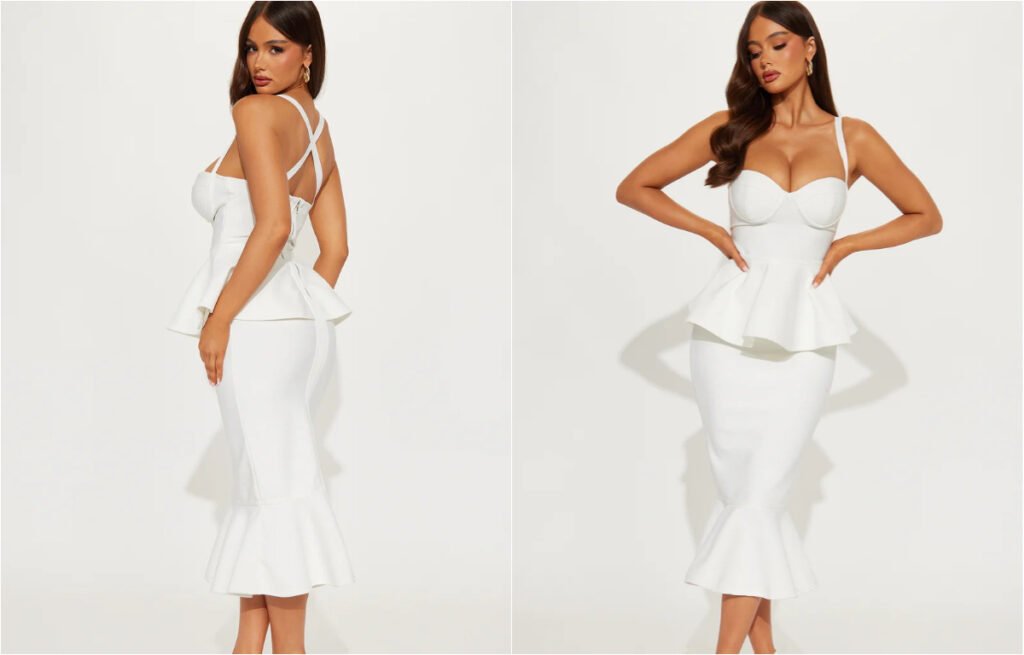
What Is a Peplum Dress and Why Is It So Unique?
Peplum dresses may seem dramatic, but what actually sets them apart—and why do they keep coming back in fashion?
A peplum dress has an extra ruffle or overskirt sewn at the waist, usually above the hips. This simple addition creates the illusion of a smaller waist, highlights curves, and adds dimension to an otherwise plain silhouette.
History, Structure, and the Power of the Peplum
Historical Roots
The peplum dates back to ancient Greece but hit its stride in the 1940s and again in the 1980s. It was reimagined on runways in the 2010s and is still used by designers for both dramatic and subtle effects.
Design Anatomy
- Waist Detail: The peplum flounce can be subtle or bold, single or layered.
- Dress Base: Often a sheath or pencil dress, but A-line and fit-and-flare work too.
- Ruffle Placement: Most commonly at the natural waist, but sometimes higher or lower for effect.
- Fabric Choices: Stiff fabrics hold shape, while softer ones create a more relaxed look.
Why It Works
- Creates Hourglass: Even straight or rectangular shapes get more curves.
- Conceals Tummy: The flare distracts from the midsection, making it a favorite for those who want a bit more coverage.
- Adds Structure: Great for work or formal events when you want to look polished.
| Feature | What It Does | Styling Tip |
|---|---|---|
| Peplum ruffle | Defines waist, adds drama | Choose size based on comfort |
| Dress base | Sheath, pencil, A-line | Fitted base balances ruffle |
| Placement | At or above natural waist | High-waist = longer legs |
| Fabric | Stiff for volume, soft for subtlety | Match mood and occasion |
My Perspective
Peplum dresses have rescued me on days I want to look more “shaped” than I actually am. When styled right, they feel both powerful and feminine.
What Are the Benefits and Drawbacks of Peplum Dresses?
Peplum dresses are eye-catching, but are they practical for every woman and every occasion?
The main benefits of peplum dresses are instant waist definition, curve creation, and visual interest. Drawbacks include the risk of adding bulk if not well-tailored, and the fact that bold peplums can overwhelm petite frames or feel too “fancy” for some settings.
Balancing Impact and Wearability
Benefits
- Flatters Many Shapes: Especially good for rectangles or straight figures.
- Boosts Confidence: Waist-cinching effect feels empowering.
- Hides Problem Areas: The ruffle can disguise a tummy or balance wider hips/shoulders.
- Day-to-Night: Many peplum dresses look professional by day and chic by night.
Drawbacks
- Can Add Bulk: Oversized or poorly placed ruffles may widen the silhouette.
- Not for Every Event: Sometimes too much for very casual occasions.
- Hard for Some Petite Builds: Shorter frames might feel “lost” in a large peplum.
| Factor | Peplum Dress Advantage | Challenge |
|---|---|---|
| Waist definition | Very strong | None if fitted well |
| Versatility | Good with classic base dress | Not ideal for casual only |
| Body type boost | Rectangles, petites, pears | Large peplums = more volume |
| Comfort | High in soft fabrics | Stiff peplums may restrict |
My Advice
Choose a peplum that matches your comfort level and the setting. Try different placements and widths until you find what flatters you most.
Off-shoulder Dress
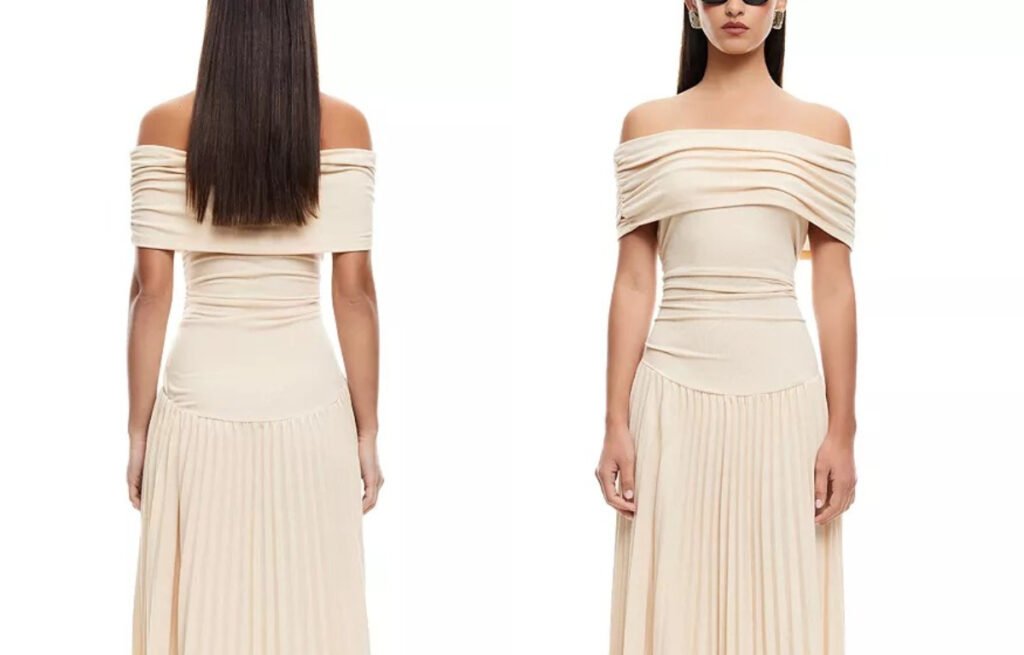
What Is an Off-Shoulder Dress and Why Is It So Popular?
Why do so many designers and style icons return to the off-shoulder shape, season after season?
An off-shoulder dress is designed so the neckline rests below the shoulders, framing the upper chest and collarbone while often using elastic or structured seams to keep it in place. Its main appeal is a balance of sensuality and elegance, making it popular for weddings, vacations, date nights, and summer events.
History, Silhouette, and Unique Appeal of the Off-Shoulder Dress
Historical Background
Off-shoulder dresses date back to Renaissance and Victorian eras, symbolizing both modesty and allure. In the 1950s and 1960s, Brigitte Bardot made the look iconic, and today the off-shoulder dress is a favorite for red carpet and resort wear alike.
Key Features
- Neckline: The key detail—rests below the shoulders, held by elastic, ruffles, or structured seams.
- Sleeves: Can be long, short, puffed, flounced, or even in a “bardot” style.
- Fit: Ranges from loose, flowy maxi styles to fitted bodycon shapes.
- Fabric Choices: Light cotton for casual, satin or lace for formal, jersey or linen for comfort.
| Feature | What It Does | Styling Tip |
|---|---|---|
| Exposed shoulders | Highlights collarbone/neck | Wear with updos or statement earrings |
| Sleeve variation | Adds drama or romance | Match sleeve style to your mood |
| Neckline | Draws attention upward | Balance with a clean, fitted waist |
| Versatility | Works for day/night, any body | Try different fabrics for each event |
My Perspective
Every time I slip into an off-shoulder dress, I feel instantly taller and more poised. It’s an easy way to add glamour, even to a simple day.
What Are the Pros and Cons of Off-Shoulder Dresses?
Off-shoulder dresses are gorgeous, but they come with their own challenges.
Off-shoulder dresses are flattering, instantly feminine, and work across dress codes. Their main downsides are the need for specific undergarments, the risk of slipping or bunching, and some movement limitations—especially when reaching overhead.
Balancing Beauty and Practicality
Pros
- Focus on Shoulders & Neck: A universally flattering feature for most women.
- Perfect for Summer: Keeps you cool and looks effortless.
- Easily Dressed Up or Down: Sandals for brunch, heels for parties.
- Flattering for Most Figures: Works especially well for pear shapes and petites.
Cons
- Bra Dilemma: Regular straps show—requires strapless or adhesive bras.
- Can Slip or Ride Up: Movement may cause the dress to shift.
- Arm Movement Limited: Raising your arms may pull the neckline up or down.
- Not Always Weather-Proof: Cold shoulders mean it’s not ideal for winter unless layered.
| Factor | Advantage | Challenge |
|---|---|---|
| Flattery | Highlights upper body | Not great for those who dislike shoulders |
| Comfort | Airy and breezy | Needs correct bra and posture |
| Versatility | Day-to-night, casual-formal | Not ideal for all seasons |
| Fit | Conceals arms, bust | May need tailoring for bust/arms |
My Advice
Always try the dress with your intended undergarments and move around before you commit. A quality strapless bra is worth every cent!
Halter Dress
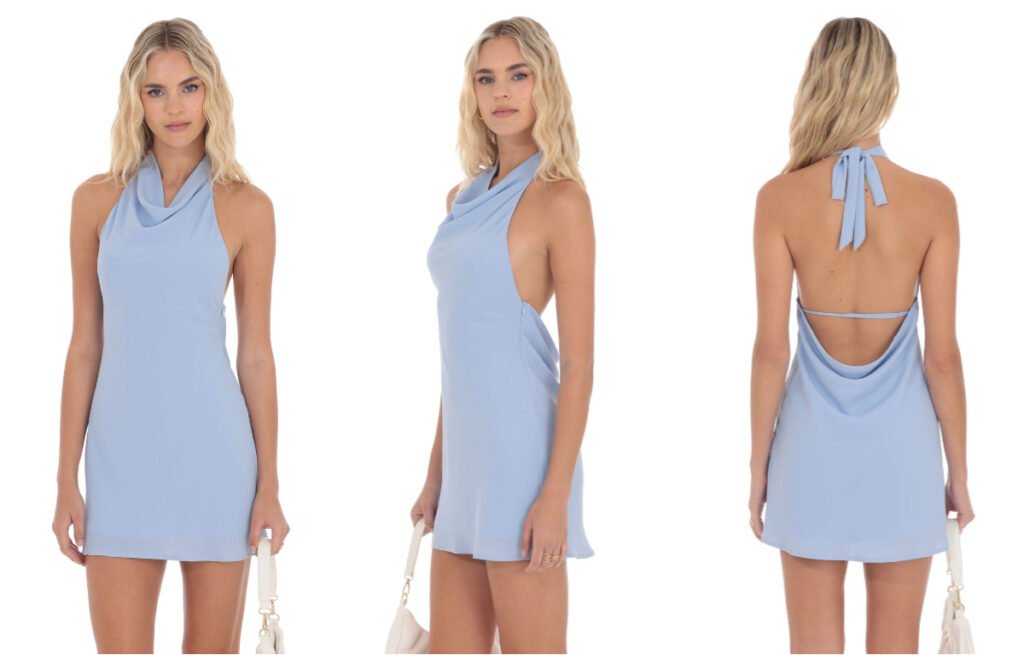
What Is a Halter Dress and What Sets It Apart?
What makes the halter neckline so enduring, and why does it flatter so many body types?
A halter dress is defined by its neckline, which fastens or ties at the back of the neck, baring the shoulders and often much of the back. Its strong vertical lines elongate the upper body, making it a top choice for both casual and formal settings.
Design, History, and Unique Appeal of the Halter Dress
The Halter’s History
The halter silhouette first gained popularity in the 1930s and 1940s for beach and evening wear. Marilyn Monroe’s famous white halter dress cemented its status as an icon, and designers continue to reinvent it in new fabrics and lengths.
Key Features
- Neckline: Fabric or straps encircle or tie behind the neck.
- Shoulders & Back: Exposed, creating an athletic and graceful effect.
- Silhouette: Can be fitted, flowy, or anything in between—works for minis, midis, and maxis.
- Fabrics: Everything from breezy cotton to silk, chiffon, and jersey.
| Feature | What It Does | Styling Tip |
|---|---|---|
| Halter neckline | Frames face, shows shoulders | Wear with statement earrings |
| Open back | Adds drama, keeps cool | Go for updos or sleek ponytails |
| Versatility | Day or evening, casual to formal | Adjust fabric/length as needed |
| Fit | Enhances shoulders, slims arms | Choose right bra for comfort |
Who Looks Good in a Halter Dress?
Halter dresses are especially flattering for:
- Athletic and hourglass shapes: Emphasizes shoulders, defines waist.
- Petite frames: Creates visual length and draws eyes upward.
- Wider hips or pear shapes: Balances the upper and lower body.
My Perspective
Whenever I want to highlight my shoulders (or just show off a tan), a halter dress is my first choice. It’s a secret weapon for summer but can look dramatic at winter parties in luxe fabrics.
What Are the Pros and Cons of Halter Dresses?
No style is perfect for everyone. What should you know before choosing a halter dress?
Halter dresses enhance the upper body, offer breathability, and can feel both sexy and sophisticated. Downsides include the challenge of finding the right bra, the risk of neck discomfort with heavy dresses, and the need for confidence with exposed shoulders and back.
Is the Halter Dress Right for You?
Pros
- Highlights Shoulders and Arms: Perfect for athletic or toned figures.
- Cool for Warm Weather: Less fabric means better airflow.
- Day-to-Night: Works for picnics, date nights, or black-tie events with a change of fabric and accessories.
- Elongates the Neck: The neckline draws eyes upward, making you look taller.
Cons
- Bra Dilemma: Most regular bras show—strapless, convertible, or adhesive bras are needed.
- Neck Strain: Heavy halter styles can put pressure on the neck after long wear.
- Skin Exposure: Not for everyone’s comfort zone.
- Tan Lines: Exposed areas mean you may get unique tan lines in the sun.
| Factor | Halter Dress Advantage | Challenge |
|---|---|---|
| Flattery | Shoulders, neck, arms | Bra and skin exposure |
| Comfort | Great in light fabrics | Neck strain in heavy materials |
| Versatility | All events and seasons | Needs smart accessory choices |
| Fit | Balances hips, elongates | Not for all bust sizes equally |
My Advice
If you’re new to halters, start with a lightweight fabric and try a few bra options at home. Confidence is key with this style!
Ball Gown
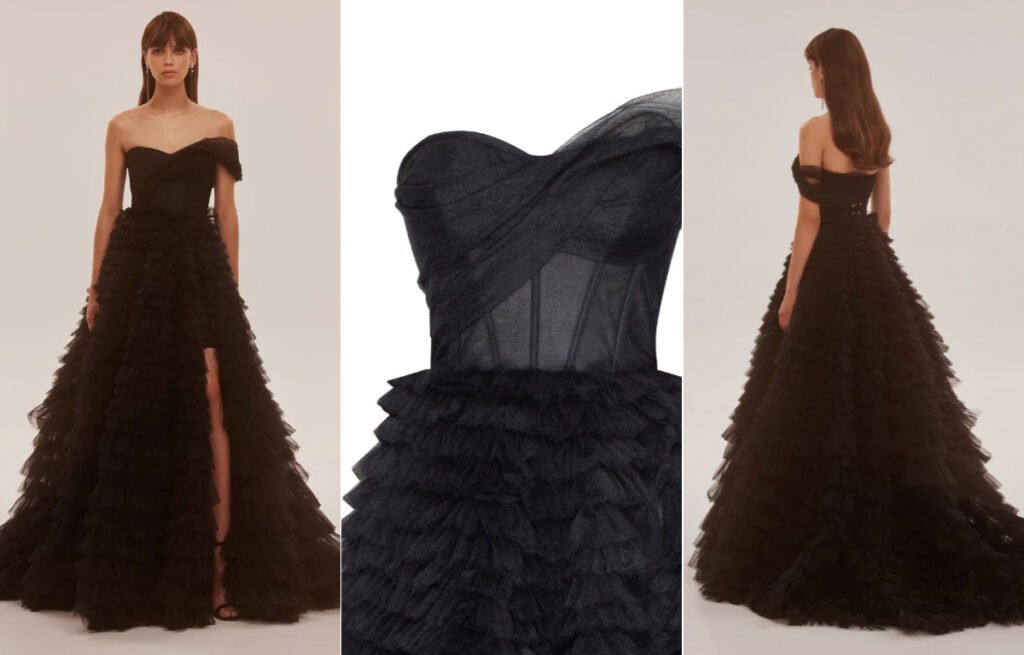
What Defines a Ball Gown and Why Is It Iconic?
What separates a ball gown from other formal dresses, and why has it become the ultimate symbol of glamour?
A ball gown is marked by a closely fitted bodice—often with a structured waist—and a very full, floor-length skirt, sometimes supported by layers of tulle or crinolines. It’s the dress code for the most formal occasions, such as balls, galas, and royal events.
History, Structure, and the Power of the Ball Gown
Historical Roots
Ball gowns date back to royal courts of the 18th and 19th centuries. They represented social status and wealth. Over time, designers like Christian Dior and Oscar de la Renta made the ball gown a fashion staple, modernizing the cut and fabrics while keeping the dramatic silhouette.
Key Elements
- Bodice: Fitted, sometimes boned or corseted for structure.
- Waist: Defined, often with embellishment or a belt.
- Skirt: Extremely full, achieved with layers of tulle, organza, or satin.
- Neckline: Can be strapless, off-shoulder, sweetheart, or high-neck.
Who Looks Good in a Ball Gown?
The ball gown is surprisingly versatile:
- Petite: Creates the illusion of height with a cinched waist.
- Curvy: Accentuates the waist, balances proportions.
- Tall: Can carry extra volume effortlessly.
| Feature | What It Does | Styling Tip |
|---|---|---|
| Fitted bodice | Defines waist, shapes torso | Get professionally tailored |
| Full skirt | Adds drama, conceals lower body | Walk and sit test for comfort |
| Length | Floor-sweeping, sometimes with train | Watch for trip hazards |
| Neckline | Frames face and shoulders | Choose to highlight best features |
My Perspective
Every client who tries on a ball gown has a “princess moment.” It’s the only silhouette that’s truly transformative, both visually and emotionally.
What Are the Pros and Cons of Wearing Ball Gowns?
Ball gowns deliver maximum glamour, but they’re not always easy to wear.
Ball gowns offer an unforgettable look, add confidence, and suit grand occasions. Their main drawbacks are bulk, movement restrictions, and the need for thoughtful undergarments and accessories.
Balancing Beauty and Practicality
Pros
- Show-Stopping Presence: No other dress has the same impact.
- Timeless Appeal: Never goes out of style for formal events.
- Hides Lower Body: Full skirt offers coverage for hips, thighs, and legs.
- Variety: Can be simple and classic or lavishly embellished.
Cons
- Heavy and Bulky: Layers can feel hot and limit movement.
- Transport and Storage: Not suitcase-friendly, often needs a garment bag.
- Limited Occasions: Best for very formal events—too much for most parties.
- Challenging to Move In: Stairs, dancing, and restrooms require planning!
| Factor | Ball Gown Advantage | Challenge |
|---|---|---|
| Drama/Presence | Maximum | Heavy, cumbersome |
| Figure-flattering | High | Needs correct proportions |
| Versatility | Formal only | Not for everyday wear |
| Comfort | Good if fitted well | Hard with long events/climate |
My Advice
If you’re wearing a ball gown, make it the star—keep accessories simple, and always try walking, sitting, and even dancing in it before the big event.
Sundress
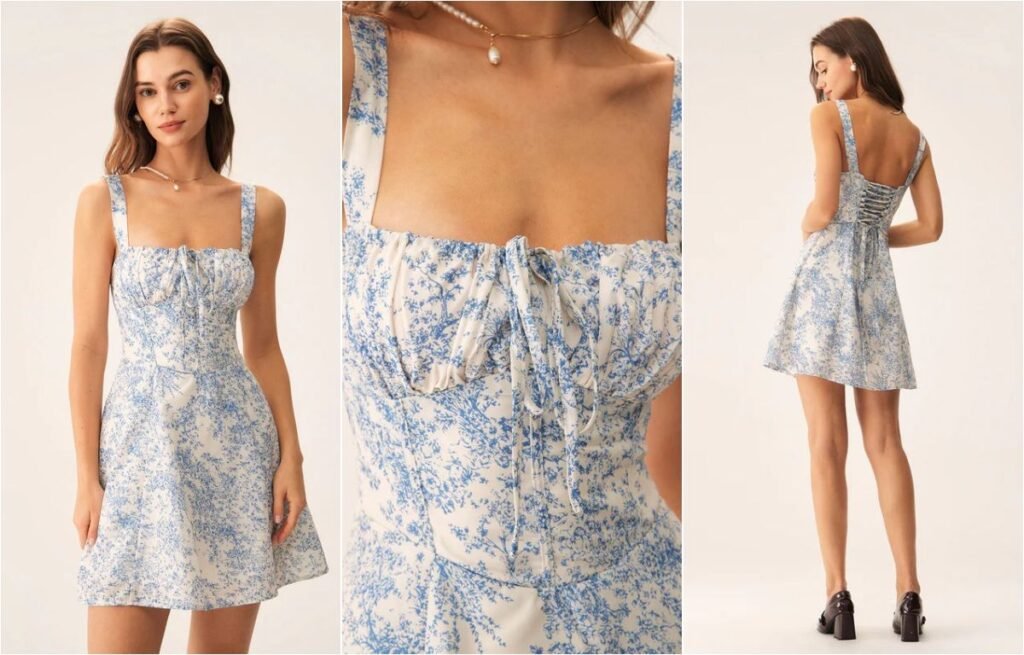
What Is a Sundress and Why Does It Scream “Summer”?
Why do we reach for sundresses the moment the sun comes out?
A sundress is defined by its sleeveless cut, lightweight fabric, and easy fit. Typically above the knee or midi length, it’s made to keep you cool, comfortable, and cute on hot days. Sundresses are a symbol of relaxed, joyful summer living.
The History, Details, and Universal Appeal of the Sundress
Origins and Evolution
The sundress became popular in the 1950s as women’s fashion moved toward more casual, outdoor-friendly styles. Since then, every era has put its own spin on the look—from ‘90s spaghetti straps to today’s smocked and tiered styles.
Key Features
- Fabric: Breathable, often cotton, linen, viscose, or rayon.
- Silhouette: Can be fitted at the bust and flowy at the skirt, A-line, wrap, or shift.
- Details: Spaghetti straps, ruffles, buttons, tie waists, or smocking.
- Prints: Florals, gingham, polka dots, tropical, or solid brights.
| Feature | Why It Matters | Styling Tip |
|---|---|---|
| Sleeveless/light | Keeps you cool in heat | Pair with a sunhat for coverage |
| Easy fit | Comfort and movement | Cinch with a belt if needed |
| Fun prints | Feels playful, casual | Add denim jacket for layering |
| Length options | Mini to midi | Choose what flatters your frame |
My Perspective
For me, sundresses mean freedom—no stress about matching separates or overheating. I reach for them all summer, whether I’m working from home or heading out for ice cream with friends.
What Are the Pros and Cons of Sundresses?
No dress is perfect for every body or every activity. What should you know before making sundresses your summer staple?
Sundresses are lightweight, comfortable, and easy to style. Their drawbacks include limited coverage, the need for special undergarments (like strapless bras), and potential see-through fabric if you’re not careful.
All the Good (and a Few Bad) Sides
Pros
- Maximum Breathability: Perfect for hot and humid weather.
- Easy to Throw On: No need to coordinate, just one piece.
- Travel-Friendly: Packs small and works for sightseeing, poolside, or dinner.
- Flattering for Many Shapes: From fitted wrap styles to roomy babydolls.
Cons
- Minimal Coverage: Not always appropriate for work or dressier events.
- Bra Dilemmas: Many require strapless or specialty bras.
- Can Be Sheer: Light fabrics sometimes need a slip or careful color choice.
- Weather Limit: Not ideal in windy or chilly conditions.
| Factor | Sundress Advantage | Drawback |
|---|---|---|
| Coolness | Maximum airflow | Can feel too bare in A/C |
| Ease of wear | One-step outfit | May need layering for formality |
| Figure-flattering | Works on most bodies | Some styles too short for comfort |
| Versatility | Day to casual night | Not for formal occasions |
My Advice
Test the fabric in sunlight and always try sitting and moving around before buying. Keep a denim jacket or lightweight cardigan handy for extra coverage when needed.
Skater Dress
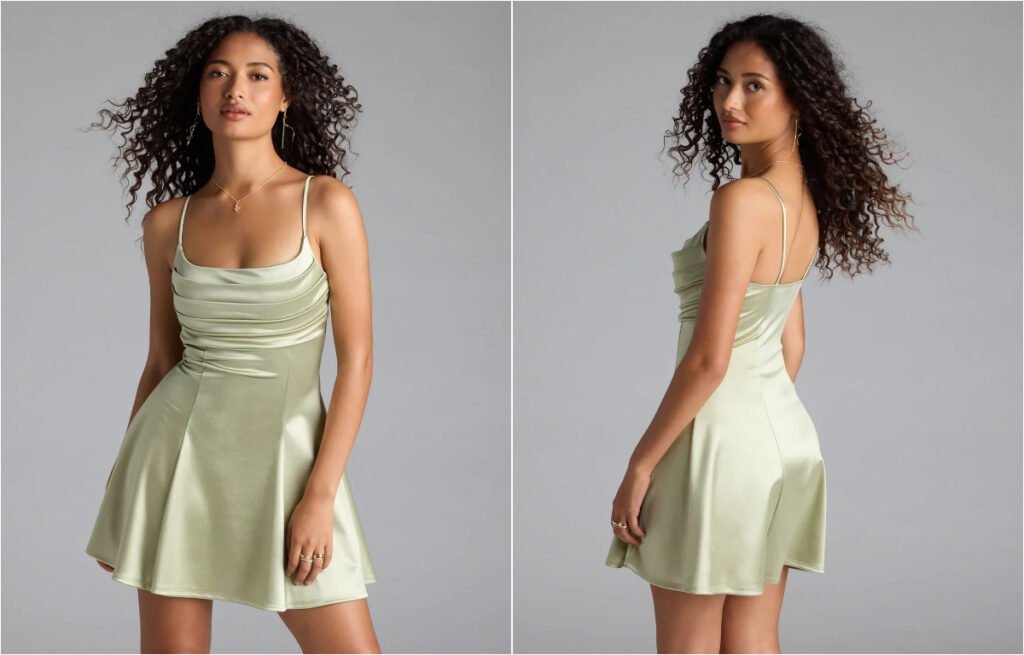
What Is a Skater Dress and Why Is It So Universally Loved?
What sets the skater dress apart from other A-line styles, and why do so many people rely on it for effortless confidence?
A skater dress is defined by its fitted top, cinched waist, and flared skirt that’s often cut above the knee. Its athletic origins inspire a design that offers comfort, ease of movement, and a playful, energetic vibe—without sacrificing a flattering fit.
Design, History, and Unique Appeal of the Skater Dress
The Skater’s Origins
Skater dresses got their name from figure skating costumes, which needed to be fitted at the top and flare out for both movement and showmanship. The style became popular in mainstream fashion during the late 1990s and 2000s for its flirty and easygoing silhouette.
Key Features
- Bodice: Fitted or lightly stretchy to hug the upper body.
- Waist: Defined, often at the natural waist or slightly above.
- Skirt: Flared, A-line, and often above the knee for a youthful look.
- Fabrics: Everything from soft jersey to structured ponte, cotton, lace, or velvet.
| Feature | Why It Matters | Styling Tip |
|---|---|---|
| Fitted bodice | Defines upper body and waist | Add a belt to highlight waist |
| Flared skirt | Adds movement, flatters hips | Choose length based on comfort |
| Short hemline | Feels playful and energetic | Tights add coverage if needed |
| Versatile fabric | Moves from casual to dressy | Try lace for events, jersey for day |
My Perspective
I was skeptical at first, thinking the shape might feel “too young.” But after styling skater dresses with blazers or ankle boots, I realized just how easy they are to dress up or down—making them a true closet MVP.
What Are the Advantages and Disadvantages of Skater Dresses?
Like any favorite style, the skater dress has its strengths and some limitations.
Skater dresses are playful, flattering, and offer total freedom of movement. They’re easy to layer and suit most figures, but shorter lengths can feel too revealing for some, and the style can look casual if not accessorized thoughtfully.
All the Pros (and a Few Cons)
Advantages
- Flattering on Most Figures: The cinched waist and flared skirt create a natural hourglass effect, even for straight or athletic bodies.
- Comfort and Movement: Perfect for dancing, walking, or just getting through a busy day.
- Easy to Dress Up or Down: Pair with sneakers for day or heels for night.
- Layer-Friendly: Works with jackets, sweaters, or tights for different seasons.
Disadvantages
- Can Feel Short: Hemlines above the knee may feel too youthful or revealing for some, especially in professional settings.
- May Skew Casual: Very basic skater dresses can feel too laid-back unless styled up.
- Body Proportion: Extremely flared skirts can overwhelm petite frames if not chosen carefully.
| Factor | Skater Dress Strength | Watch-Out |
|---|---|---|
| Flattery | High for most shapes | Length and flare matter for petites |
| Comfort | Great for active days | Skirt may ride up when sitting |
| Versatility | Day-to-night with accessories | Can be too casual for formal |
| Movement | Excellent | Watch for windy weather! |
My Advice
If you’re worried about the length, try layering with opaque tights or biker shorts. You can always add polish with a fitted blazer or heeled boots.
Mermaid Dress
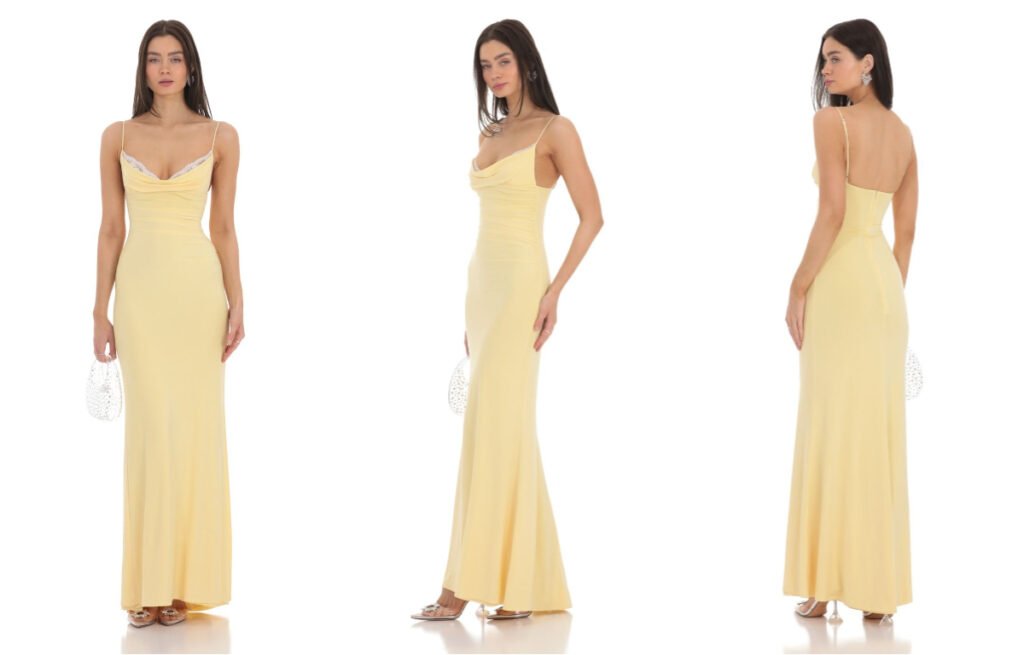
What Is a Mermaid Dress and Why Does It Stand Out?
Why is the mermaid silhouette a favorite for red carpet events and statement bridal looks?
A mermaid dress is defined by its close fit through the bodice, waist, and hips, then dramatically flares out below the knees. This shape creates an hourglass illusion, emphasizing curves and offering maximum visual impact for special occasions.
History, Structure, and the Drama of the Mermaid Dress
The Mermaid’s Story
The mermaid silhouette gained popularity in the 1930s, became iconic in mid-century Hollywood, and remains a top choice for glamorous events today. Designers use different fabrics, from structured satin to stretch crepe, to craft a perfect blend of elegance and drama.
Key Features
- Bodice: Fitted from bust to knee, sometimes boned or lined for extra structure.
- Waist/Hips: Closely follows natural curves, often with strategic seaming.
- Skirt: Flares out below the knee into a trumpet or fishtail shape.
- Length: Floor-length is most common, with or without a train.
| Feature | What It Does | Styling Tip |
|---|---|---|
| Fitted bodice | Sculpts waist, hips, thighs | Consider shapewear for smooth lines |
| Flared skirt | Adds drama and movement | Walk and sit-test before wearing |
| Fabric choice | Structured or stretchy | Stretch gives more comfort |
| Neckline | Can be strapless, halter, off-shoulder | Pick what flatters upper body |
My Perspective
Mermaid dresses feel transformative. I’ve seen clients go from nervous to “star of the night” the moment they step into this silhouette.
What Are the Pros and Cons of Mermaid Dresses?
No other dress delivers the same drama—but the mermaid requires attention to comfort and fit.
Mermaid dresses create a stunning hourglass effect, draw all eyes at formal events, and offer endless ways to personalize the look. Their drawbacks include limited mobility, the need for perfect fit, and the challenge of finding the right undergarments.
When the Mermaid Dress Shines (and When It Doesn’t)
Pros
- Maximum Glamour: Perfect for galas, weddings, and milestone celebrations.
- Enhances Curves: Flattering for hourglass, pear, or even rectangular figures with the right details.
- Customizable: Endless neckline and fabric options—make it your own.
- Photographs Beautifully: The silhouette always pops in photos.
Cons
- Movement Restriction: The fitted skirt makes sitting, walking, or dancing a challenge.
- Fit Must Be Precise: Too tight is uncomfortable, too loose loses the effect.
- Undergarment Issues: Requires seamless shapewear or support for a smooth line.
- Not for Everyone: Can feel too bold or formal for low-key events.
| Factor | Mermaid Dress Strength | Drawback |
|---|---|---|
| Flattery | Defines curves dramatically | Unforgiving if fit is off |
| Impact | Makes a memorable entrance | Not for casual occasions |
| Versatility | Suits all ages (with fit) | Hard to tailor for big changes |
| Comfort | Depends on fabric/construction | Movement may be restricted |
My Advice
Don’t compromise on alterations. A custom fit makes all the difference—especially at the knees and hips. And always practice walking and sitting before your big event!
T-shirt Dress
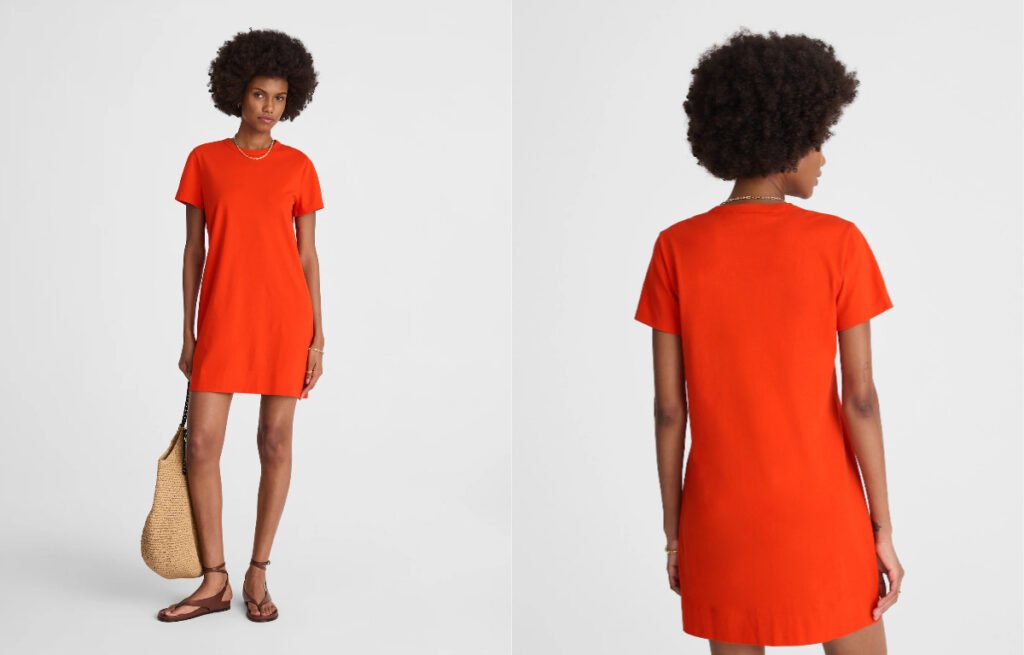
What Is a T-shirt Dress and Why Is It So Popular?
What’s the magic behind this “just throw it on” style?
A T-shirt dress combines the best parts of a tee—soft fabric, relaxed fit, ease of movement—with the length and coverage of a dress. It can be boxy or gently shaped, short or midi, and comes in solids, stripes, or playful graphics. The best part? You don’t have to overthink it.
Design, History, and Everyday Appeal
Where Did It Come From?
The T-shirt dress emerged as women started adopting more casual, sporty styles in the late 20th century. Brands quickly realized the demand for something that was both “throw-on-and-go” and style-conscious. Today, it’s a mainstay in capsule wardrobes and airport style roundups.
Key Features
- Shape: Straight or slightly A-line, rarely fitted, often hits above the knee.
- Neckline: Classic crew, scoop, or V-neck—just like a tee.
- Fabric: Cotton, jersey, or bamboo for stretch and breathability.
- Details: Sometimes pockets, side slits, or a chest patch pocket.
| Feature | What It Does | Styling Tip |
|---|---|---|
| Relaxed fit | Allows comfort, easy movement | Add a belt for more waist |
| Soft fabric | Feels like pajamas | Opt for thicker jersey for polish |
| Short length | Keeps it casual, cool | Try midi for more coverage |
| Simple style | Layering is easy | Use jackets to add interest |
My Perspective
I rely on T-shirt dresses for both lazy Sundays and business trips. They’re the perfect foundation for creative, personalized styling—or just keeping it ultra-simple.
What Are the Pros and Cons of T-shirt Dresses?
No dress is right for every mood or event. Here’s the reality check for T-shirt dresses.
T-shirt dresses are ultra-comfortable, easy to care for, and endlessly versatile. Their drawbacks are that they can look shapeless or too casual if not styled thoughtfully, and may require accessories or layering to avoid feeling underdressed.
All the Benefits—and the Limits
Pros
- Maximum Comfort: Feels like a long tee—no pinching, no structure.
- Easy to Style: Sneakers, sandals, boots, or even heels can work.
- Low Maintenance: Most can go in the wash and require no ironing.
- Ideal for Layering: Works under jackets, cardigans, or over leggings.
Cons
- Can Look Boxy: The straight fit may not flatter every body unless styled.
- Thin Fabric Risk: Lower-quality options can be see-through or clingy.
- Too Casual for Some Events: Not for work meetings or formal occasions.
- Needs Accessories for Shape: Sometimes a belt or jacket is essential.
| Factor | T-shirt Dress Strength | Drawback |
|---|---|---|
| Comfort | Top-tier | May lack structure |
| Versatility | High with right styling | May need layers or belt |
| Care | Easy—just wash and wear | Can stretch out over time |
| Figure-flattering | Depends on fit and styling | Boxy on some body types |
My Advice
Try before you buy, and don’t be afraid to size up for a true relaxed look—or down for a slightly more fitted vibe. Always check fabric thickness in good light.
Blazer Dress
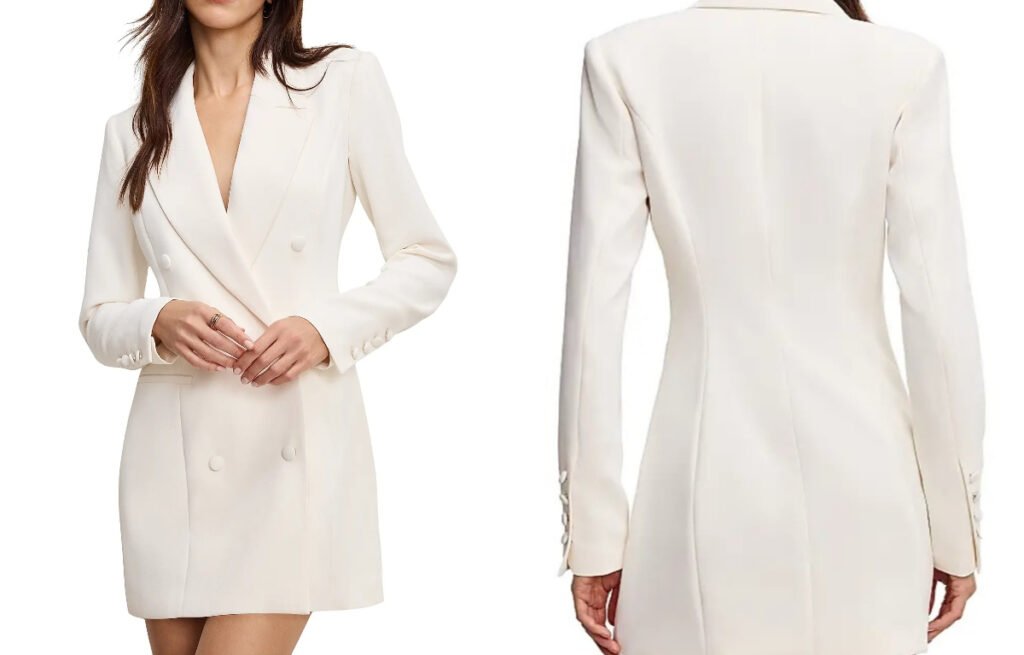
What Is a Blazer Dress and Why Is It Trending?
What separates a blazer dress from other tailored pieces, and why do modern professionals and influencers love it?
A blazer dress is a tailored dress designed with classic blazer details—lapels, structured shoulders, button or wrap closure, and often a belt at the waist. It can be fitted or slightly oversized, with lengths from mid-thigh to knee. This dress bridges the gap between workwear and evening style, making it a fashion-forward, versatile staple.
History, Details, and the Fashion Impact of the Blazer Dress
The Blazer Dress Evolution
Inspired by menswear and the power dressing movement of the 1980s, the blazer dress blends business with a touch of rebellion. Designers like Yves Saint Laurent, Alexander McQueen, and many more have put their spin on this confident silhouette, making it a runway and red carpet favorite in recent years.
Key Features
- Structure: Strong shoulders, lapels, and clean lines define the shape.
- Closure: Buttons or wrap style, often double-breasted for a bold look.
- Length: Mini to knee-length, sometimes with a subtle slit.
- Fabric: Suiting wool, crepe, tweed, or even vegan leather for edge.
- Details: May have pockets, a self-tie belt, or accent buttons.
| Feature | What It Does | Styling Tip |
|---|---|---|
| Strong lines | Projects confidence and power | Belt the waist for definition |
| Classic details | Feels timeless and tailored | Try bold accessories for fun |
| Mini/short cut | Adds femininity to tailoring | Wear with shorts for coverage |
| Versatile fabric | Moves from day to night easily | Swap shoes to shift the mood |
My Perspective
For days when I need to command the room—or just want to feel my best—I reach for a blazer dress. It’s the quickest way to make a strong impression without feeling overdressed or stiff.
What Are the Pros and Cons of Blazer Dresses?
Blazer dresses are powerful, but they’re not for every mood or body type.
Blazer dresses offer structure, versatility, and instant style authority. Their main drawbacks are fit challenges (especially for curvy or petite frames), the risk of looking too boxy or short, and needing careful attention to undergarments and accessories.
The Balance of Power and Practicality
Pros
- Instantly Polished: Makes you look professional and stylish in one step.
- Transitional: Moves from office to dinner, or day to night, with ease.
- Works for All Seasons: Layer with tights and boots, or go bare-legged in spring.
- Trend-Proof: The tailored look never truly goes out of style.
Cons
- Fit is Everything: Poor tailoring can look boxy or overwhelm petite frames.
- Can Feel Short: Many styles are mini; consider wearing shorts or tights underneath.
- Needs Smart Accessories: Wrong shoes or bags can make the look too harsh or too casual.
- Not for Every Figure: Can accentuate broad shoulders or minimize curves.
| Factor | Blazer Dress Advantage | Drawback |
|---|---|---|
| Authority | Looks strong and confident | Fit issues for some bodies |
| Flexibility | Day, night, any season | May feel too bold for some |
| Comfort | Tailored, but not stiff | May need stretch or lining |
| Figure-flattering | Defines waist with belt | Beware of boxy or bulky styles |
My Advice
Try several cuts and lengths, and don’t hesitate to tailor the shoulders, waist, or hem for a perfect fit. For minis, biker shorts add comfort and coverage.
Tea Dress

What Is a Tea Dress and Why Does It Feel Timeless?
Why do tea dresses still pop up in every vintage-inspired collection and trend report?
A tea dress is defined by its midi length, semi-fitted bodice, and lightly flared skirt. Made from soft fabrics and often featuring floral or polka dot prints, tea dresses create an easy, feminine look that’s perfect for both relaxed and special daytime events.
Origins, Design Details, and Unique Charm
History of the Tea Dress
Tea dresses date back to the early 1900s, when women wore them for at-home entertaining and afternoon tea. The design was meant to be more relaxed than formal gowns but still ladylike. Today, the tea dress is celebrated as a vintage-inspired staple that works across ages and settings.
Key Features
- Length: Midi, usually hitting mid-calf or just below the knee.
- Bodice: Slightly fitted, sometimes with darts, buttons, or wrap styling.
- Sleeves: Short, flutter, cap, or 3/4 length.
- Skirt: Gentle flare—never too tight or too wide.
- Prints: Florals, polka dots, or solids in soft colors.
- Details: Tie waists, ruffles, or subtle lace for added interest.
| Feature | What It Does | Styling Tip |
|---|---|---|
| Midi length | Feels classic, suits all heights | Try heels or sandals for balance |
| Soft fabric | Comfortable, easy movement | Go for viscose or rayon for drape |
| Feminine details | Adds romance and interest | Keep accessories simple |
| Gentle flare | Flatters without clinging | Belt the waist for definition |
My Perspective
The tea dress always makes me feel a bit more polished—even on days when I just need comfort. It’s a way to look like I tried, without any effort at all.
What Are the Pros and Cons of Tea Dresses?
Tea dresses are charming, but they’re not for every mood or body type. Here’s what to know.
Tea dresses are flattering, comfortable, and endlessly wearable for most daytime occasions. Their main limitations are that they can feel too vintage for very modern tastes, and require thoughtful styling to avoid looking costume-y or too casual for formal events.
Where Tea Dresses Shine (and Where They Don’t)
Pros
- Flattering for Most Figures: The midi length and gentle waist work on curvy, petite, or tall frames.
- Comfortable for All-Day Wear: Breathable fabrics and relaxed fit.
- Transitional: Works for office, brunch, weddings, and everything in between.
- Timeless Appeal: Always feels a little bit “special.”
Cons
- Can Feel Old-Fashioned: Needs modern accessories to avoid a costume look.
- Not Always Dressy Enough: May be too informal for black-tie or evening events.
- Print Overload: Some prints can feel overwhelming—balance with simple shoes.
| Factor | Tea Dress Advantage | Drawback |
|---|---|---|
| Flattery | Universal with right fit | Avoid too much fabric if petite |
| Comfort | Easy to move and wear | May need slip for thin fabrics |
| Versatility | Day-to-night with layers | Not for formal evening wear |
| Styling | Feminine, classic | Needs modern touch to update |
My Advice
Choose tea dresses in modern prints or colors if you want a fresher look. Don’t be afraid to add a denim jacket or chunky sandals to keep it current.
What Are the Common Mistakes When Selecting Dress Types?
Picking a dress can feel like a gamble. Many women make the same mistakes. If you spot these errors, you can avoid frustration and regret.
The most common mistakes are ignoring your body shape, following trends blindly, picking the wrong fabric for the event, and not checking dress fit from all angles. Being mindful of these helps you look and feel better in any dress.
How Can You Avoid the Biggest Dress Selection Pitfalls?
1. Ignoring Your Body Shape
One mistake I see: women choose dresses that don’t fit their bodies. For example, petite women drown in long maxis. Pear-shaped women may not flatter their figure in a straight shift dress. I learned to measure my proportions and check guides before buying.
2. Following Trends Without Considering Personal Style
Trends change fast. What works for a runway model may not work for everyone. I once bought a neon bodycon because it was trending—wore it once, never again. Always ask: “Does this match my lifestyle and comfort?”
3. Neglecting Fabric Choice
A stunning dress can look cheap if the fabric is wrong. I advise clients to touch and feel the material. Heavy fabrics work for winter and structure, while lightweight fabrics suit summer and movement. I once wore polyester to an outdoor event and regretted it for hours.
4. Not Trying the Dress from Every Angle
Fit is more than what you see in the mirror. Sit, walk, and move in the dress. I encourage trying on under different lighting and with the right underwear. I used to skip this step and paid the price with wardrobe malfunctions.
5. Forgetting Occasion Appropriateness
Some dresses look great in photos but aren’t practical. For example, sequins are not for office meetings. I always consider the event’s mood and dress code.
6. Overlooking Alteration Needs
Many dresses need minor tailoring to fit perfectly. Skipping this step can make even the best style look sloppy. I now budget for alterations on every new dress.
Common Mistake Table
| Mistake | Why It Matters | My Fix |
|---|---|---|
| Wrong style for body shape | Unflattering silhouette | Know your proportions |
| Blindly following trends | Waste of money, low confidence | Choose what feels “you” |
| Wrong fabric | Discomfort, poor appearance | Feel and check fabrics |
| No movement test | Surprises during wear | Move, sit, check all angles |
| Ignoring the event | Out of place, embarrassment | Research occasion expectations |
| No alterations | Poor fit, wasted investment | Budget for tailoring |
My Advice
Mistakes are normal. But learning from them makes you a smarter shopper. I encourage my clients to ask for advice, take photos, and try multiple styles before buying. Don’t be afraid to return or exchange.
Conclusion
Knowing dress types and common mistakes will help you shop smarter and wear your choices with confidence. With practice and the right knowledge, every woman can find her perfect style and feel great in any dress.
In Part 2, we’ll dive deeper into how to choose the right dress for your body type, and in Part 3, we’ll explore the best dresses for different occasions, ensuring you’re always dressed for success.


